Observation on Innovation In Technology and its impact in Accounting
VerifiedAdded on 2023/06/04
|28
|6588
|153
AI Summary
This research paper evaluates the Observation on Innovation In Technology and its impact on Accounting. It explains the managerial implications of employing recent innovation within the accounting processes in companies.
Contribute Materials
Your contribution can guide someone’s learning journey. Share your
documents today.
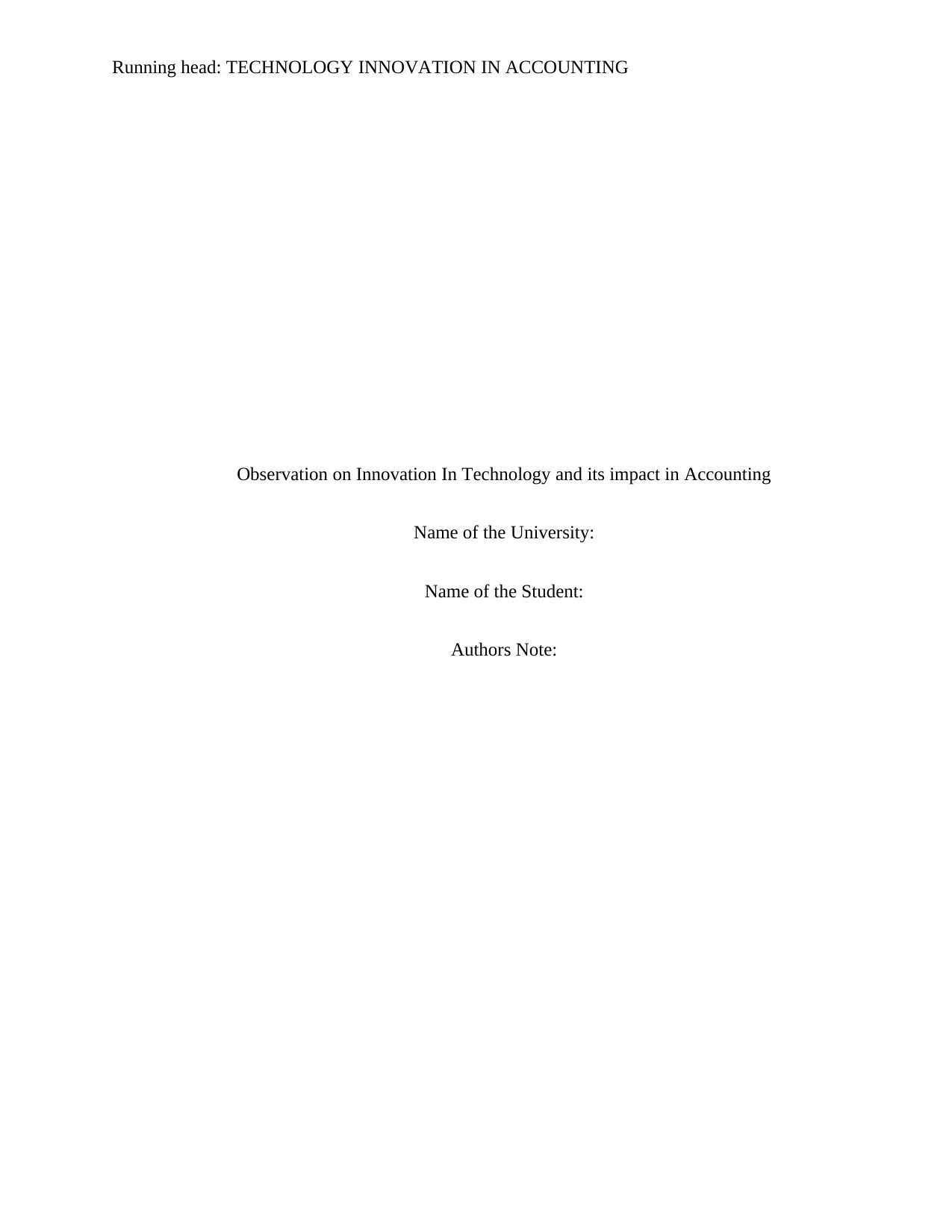
Running head: TECHNOLOGY INNOVATION IN ACCOUNTING
Observation on Innovation In Technology and its impact in Accounting
Name of the University:
Name of the Student:
Authors Note:
Observation on Innovation In Technology and its impact in Accounting
Name of the University:
Name of the Student:
Authors Note:
Secure Best Marks with AI Grader
Need help grading? Try our AI Grader for instant feedback on your assignments.
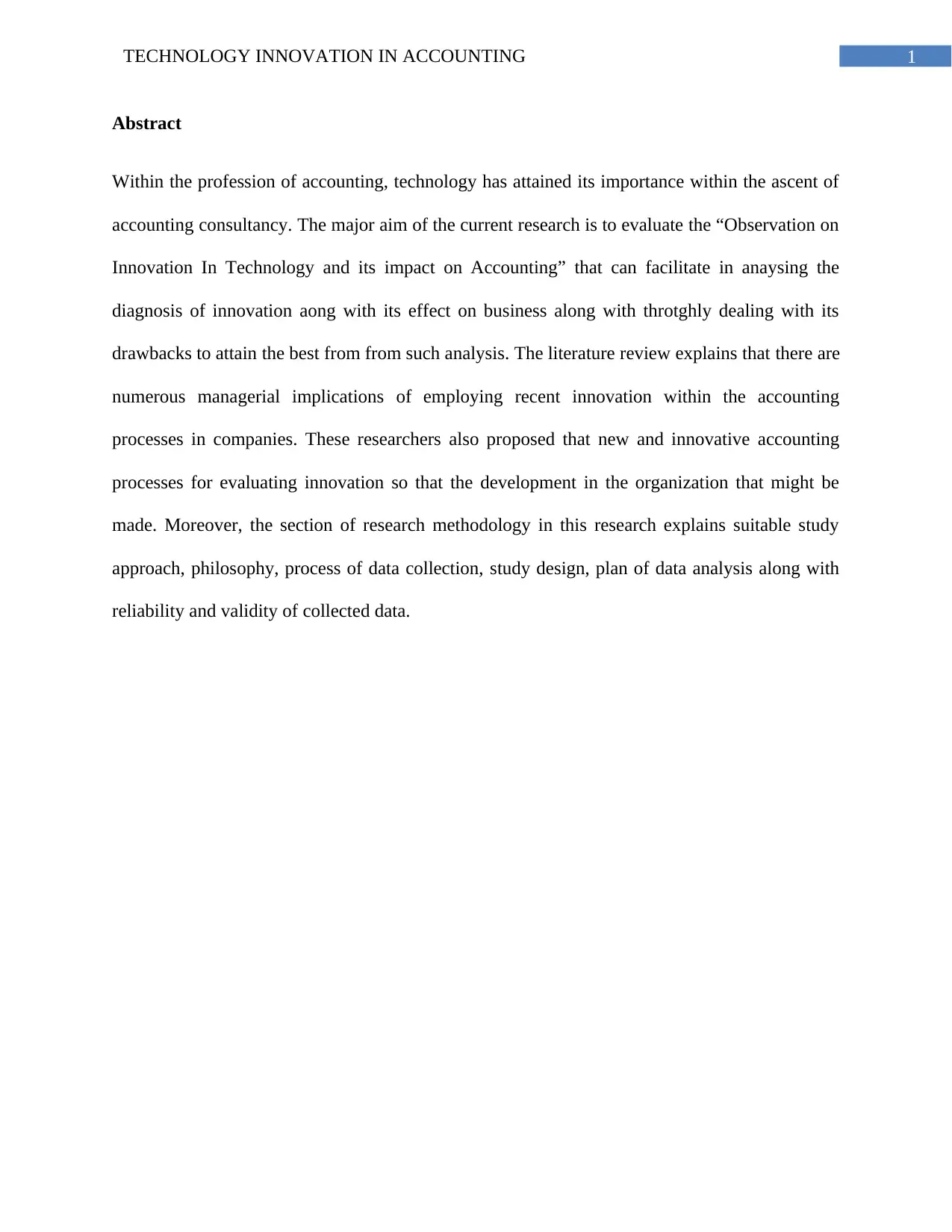
1TECHNOLOGY INNOVATION IN ACCOUNTING
Abstract
Within the profession of accounting, technology has attained its importance within the ascent of
accounting consultancy. The major aim of the current research is to evaluate the “Observation on
Innovation In Technology and its impact on Accounting” that can facilitate in anaysing the
diagnosis of innovation aong with its effect on business along with throtghly dealing with its
drawbacks to attain the best from from such analysis. The literature review explains that there are
numerous managerial implications of employing recent innovation within the accounting
processes in companies. These researchers also proposed that new and innovative accounting
processes for evaluating innovation so that the development in the organization that might be
made. Moreover, the section of research methodology in this research explains suitable study
approach, philosophy, process of data collection, study design, plan of data analysis along with
reliability and validity of collected data.
Abstract
Within the profession of accounting, technology has attained its importance within the ascent of
accounting consultancy. The major aim of the current research is to evaluate the “Observation on
Innovation In Technology and its impact on Accounting” that can facilitate in anaysing the
diagnosis of innovation aong with its effect on business along with throtghly dealing with its
drawbacks to attain the best from from such analysis. The literature review explains that there are
numerous managerial implications of employing recent innovation within the accounting
processes in companies. These researchers also proposed that new and innovative accounting
processes for evaluating innovation so that the development in the organization that might be
made. Moreover, the section of research methodology in this research explains suitable study
approach, philosophy, process of data collection, study design, plan of data analysis along with
reliability and validity of collected data.

2TECHNOLOGY INNOVATION IN ACCOUNTING
Table of Contents
1. The Research Problem.....................................................................................................4
2. Research Background......................................................................................................5
3. Ethical Consideration.......................................................................................................6
4. Literature Review............................................................................................................7
4.1. Introduction...............................................................................................................7
4.2. Impact of Innovation in Accounting.........................................................................9
4.3. Managerial Implication of Accounting Innovation within Organizations..............10
4.4. Research Gap..........................................................................................................11
4.5. Summary.................................................................................................................12
5. Aims/ Objectives of Research.......................................................................................12
6. Research Design or Methodology.................................................................................13
6.1. Introduction.............................................................................................................13
6.2. Philosophy of Research..........................................................................................13
6.3. Approach of Research.............................................................................................14
6.4. Research Design.....................................................................................................15
6.5. Data Collection Technique.....................................................................................15
6.6. Data Analysis..........................................................................................................16
6.7. Sampling and Sample Size....................................................................................16
Table of Contents
1. The Research Problem.....................................................................................................4
2. Research Background......................................................................................................5
3. Ethical Consideration.......................................................................................................6
4. Literature Review............................................................................................................7
4.1. Introduction...............................................................................................................7
4.2. Impact of Innovation in Accounting.........................................................................9
4.3. Managerial Implication of Accounting Innovation within Organizations..............10
4.4. Research Gap..........................................................................................................11
4.5. Summary.................................................................................................................12
5. Aims/ Objectives of Research.......................................................................................12
6. Research Design or Methodology.................................................................................13
6.1. Introduction.............................................................................................................13
6.2. Philosophy of Research..........................................................................................13
6.3. Approach of Research.............................................................................................14
6.4. Research Design.....................................................................................................15
6.5. Data Collection Technique.....................................................................................15
6.6. Data Analysis..........................................................................................................16
6.7. Sampling and Sample Size....................................................................................16
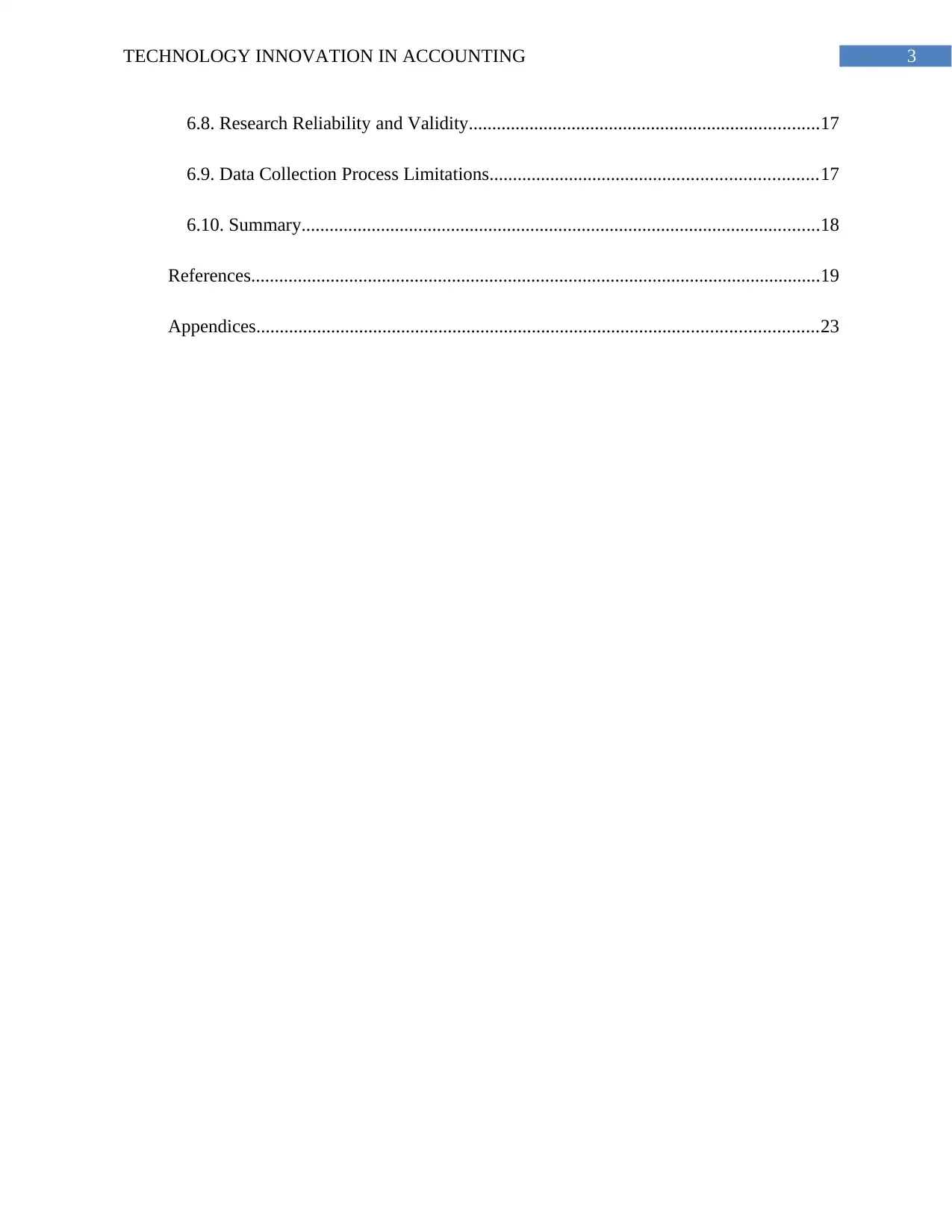
3TECHNOLOGY INNOVATION IN ACCOUNTING
6.8. Research Reliability and Validity...........................................................................17
6.9. Data Collection Process Limitations......................................................................17
6.10. Summary...............................................................................................................18
References..........................................................................................................................19
Appendices........................................................................................................................23
6.8. Research Reliability and Validity...........................................................................17
6.9. Data Collection Process Limitations......................................................................17
6.10. Summary...............................................................................................................18
References..........................................................................................................................19
Appendices........................................................................................................................23
Secure Best Marks with AI Grader
Need help grading? Try our AI Grader for instant feedback on your assignments.
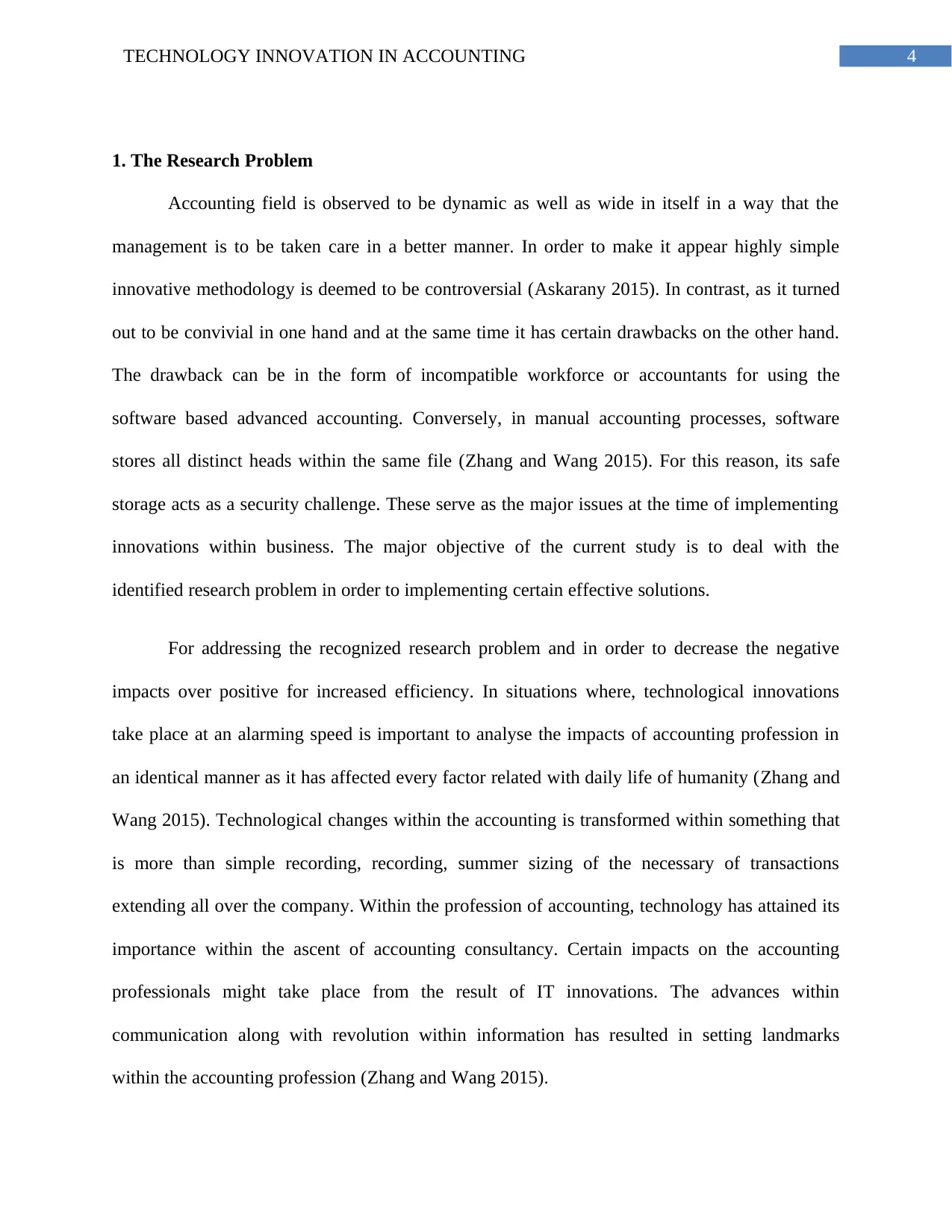
4TECHNOLOGY INNOVATION IN ACCOUNTING
1. The Research Problem
Accounting field is observed to be dynamic as well as wide in itself in a way that the
management is to be taken care in a better manner. In order to make it appear highly simple
innovative methodology is deemed to be controversial (Askarany 2015). In contrast, as it turned
out to be convivial in one hand and at the same time it has certain drawbacks on the other hand.
The drawback can be in the form of incompatible workforce or accountants for using the
software based advanced accounting. Conversely, in manual accounting processes, software
stores all distinct heads within the same file (Zhang and Wang 2015). For this reason, its safe
storage acts as a security challenge. These serve as the major issues at the time of implementing
innovations within business. The major objective of the current study is to deal with the
identified research problem in order to implementing certain effective solutions.
For addressing the recognized research problem and in order to decrease the negative
impacts over positive for increased efficiency. In situations where, technological innovations
take place at an alarming speed is important to analyse the impacts of accounting profession in
an identical manner as it has affected every factor related with daily life of humanity (Zhang and
Wang 2015). Technological changes within the accounting is transformed within something that
is more than simple recording, recording, summer sizing of the necessary of transactions
extending all over the company. Within the profession of accounting, technology has attained its
importance within the ascent of accounting consultancy. Certain impacts on the accounting
professionals might take place from the result of IT innovations. The advances within
communication along with revolution within information has resulted in setting landmarks
within the accounting profession (Zhang and Wang 2015).
1. The Research Problem
Accounting field is observed to be dynamic as well as wide in itself in a way that the
management is to be taken care in a better manner. In order to make it appear highly simple
innovative methodology is deemed to be controversial (Askarany 2015). In contrast, as it turned
out to be convivial in one hand and at the same time it has certain drawbacks on the other hand.
The drawback can be in the form of incompatible workforce or accountants for using the
software based advanced accounting. Conversely, in manual accounting processes, software
stores all distinct heads within the same file (Zhang and Wang 2015). For this reason, its safe
storage acts as a security challenge. These serve as the major issues at the time of implementing
innovations within business. The major objective of the current study is to deal with the
identified research problem in order to implementing certain effective solutions.
For addressing the recognized research problem and in order to decrease the negative
impacts over positive for increased efficiency. In situations where, technological innovations
take place at an alarming speed is important to analyse the impacts of accounting profession in
an identical manner as it has affected every factor related with daily life of humanity (Zhang and
Wang 2015). Technological changes within the accounting is transformed within something that
is more than simple recording, recording, summer sizing of the necessary of transactions
extending all over the company. Within the profession of accounting, technology has attained its
importance within the ascent of accounting consultancy. Certain impacts on the accounting
professionals might take place from the result of IT innovations. The advances within
communication along with revolution within information has resulted in setting landmarks
within the accounting profession (Zhang and Wang 2015).
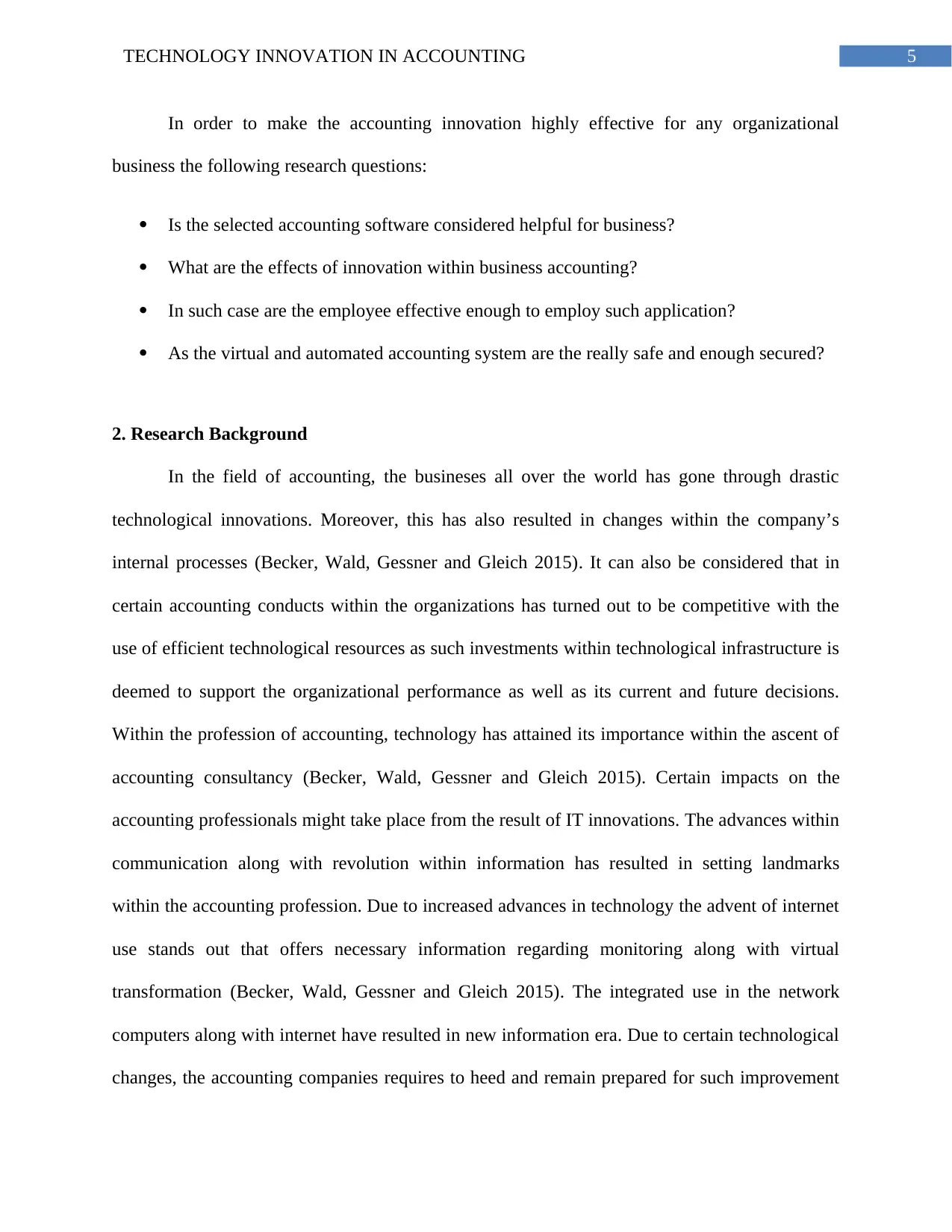
5TECHNOLOGY INNOVATION IN ACCOUNTING
In order to make the accounting innovation highly effective for any organizational
business the following research questions:
Is the selected accounting software considered helpful for business?
What are the effects of innovation within business accounting?
In such case are the employee effective enough to employ such application?
As the virtual and automated accounting system are the really safe and enough secured?
2. Research Background
In the field of accounting, the busineses all over the world has gone through drastic
technological innovations. Moreover, this has also resulted in changes within the company’s
internal processes (Becker, Wald, Gessner and Gleich 2015). It can also be considered that in
certain accounting conducts within the organizations has turned out to be competitive with the
use of efficient technological resources as such investments within technological infrastructure is
deemed to support the organizational performance as well as its current and future decisions.
Within the profession of accounting, technology has attained its importance within the ascent of
accounting consultancy (Becker, Wald, Gessner and Gleich 2015). Certain impacts on the
accounting professionals might take place from the result of IT innovations. The advances within
communication along with revolution within information has resulted in setting landmarks
within the accounting profession. Due to increased advances in technology the advent of internet
use stands out that offers necessary information regarding monitoring along with virtual
transformation (Becker, Wald, Gessner and Gleich 2015). The integrated use in the network
computers along with internet have resulted in new information era. Due to certain technological
changes, the accounting companies requires to heed and remain prepared for such improvement
In order to make the accounting innovation highly effective for any organizational
business the following research questions:
Is the selected accounting software considered helpful for business?
What are the effects of innovation within business accounting?
In such case are the employee effective enough to employ such application?
As the virtual and automated accounting system are the really safe and enough secured?
2. Research Background
In the field of accounting, the busineses all over the world has gone through drastic
technological innovations. Moreover, this has also resulted in changes within the company’s
internal processes (Becker, Wald, Gessner and Gleich 2015). It can also be considered that in
certain accounting conducts within the organizations has turned out to be competitive with the
use of efficient technological resources as such investments within technological infrastructure is
deemed to support the organizational performance as well as its current and future decisions.
Within the profession of accounting, technology has attained its importance within the ascent of
accounting consultancy (Becker, Wald, Gessner and Gleich 2015). Certain impacts on the
accounting professionals might take place from the result of IT innovations. The advances within
communication along with revolution within information has resulted in setting landmarks
within the accounting profession. Due to increased advances in technology the advent of internet
use stands out that offers necessary information regarding monitoring along with virtual
transformation (Becker, Wald, Gessner and Gleich 2015). The integrated use in the network
computers along with internet have resulted in new information era. Due to certain technological
changes, the accounting companies requires to heed and remain prepared for such improvement
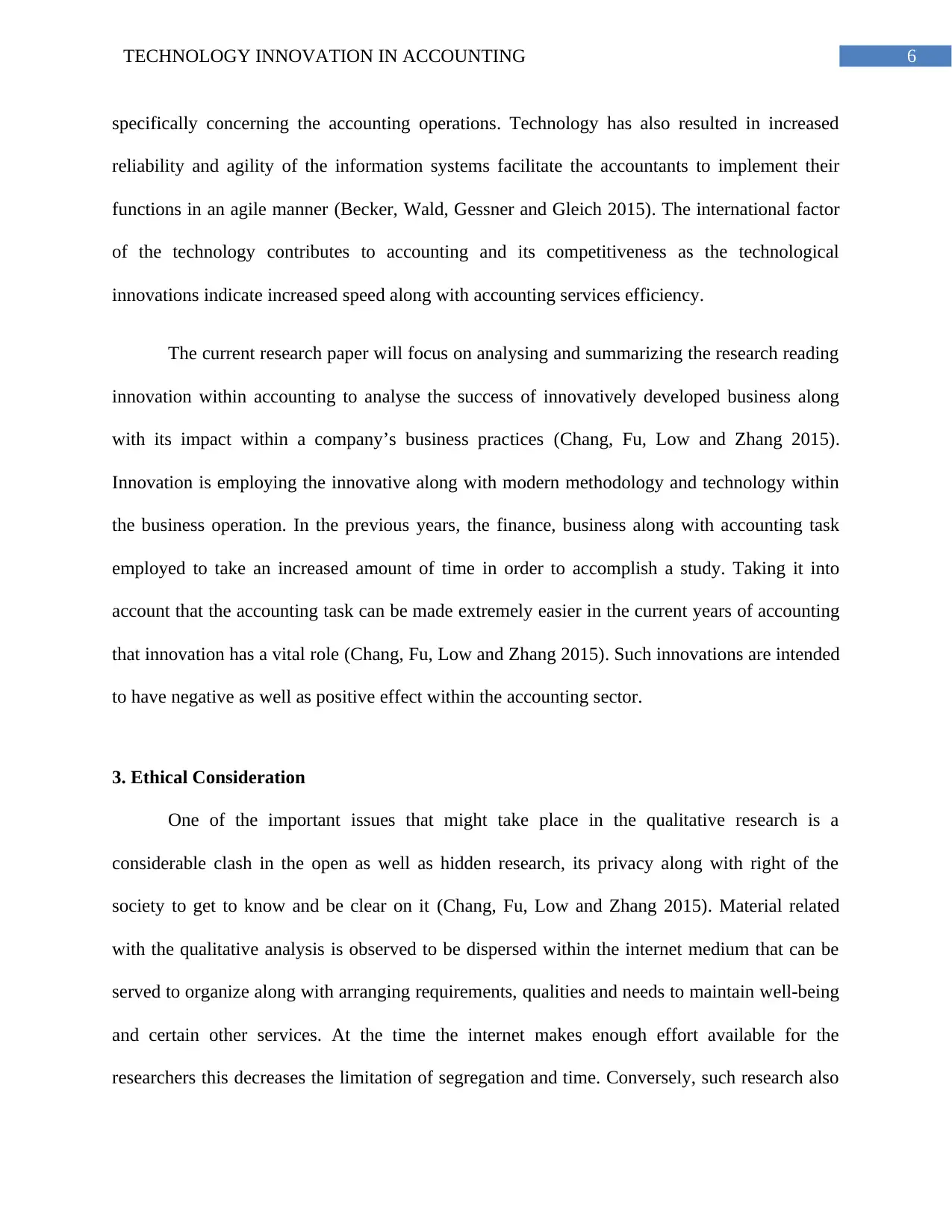
6TECHNOLOGY INNOVATION IN ACCOUNTING
specifically concerning the accounting operations. Technology has also resulted in increased
reliability and agility of the information systems facilitate the accountants to implement their
functions in an agile manner (Becker, Wald, Gessner and Gleich 2015). The international factor
of the technology contributes to accounting and its competitiveness as the technological
innovations indicate increased speed along with accounting services efficiency.
The current research paper will focus on analysing and summarizing the research reading
innovation within accounting to analyse the success of innovatively developed business along
with its impact within a company’s business practices (Chang, Fu, Low and Zhang 2015).
Innovation is employing the innovative along with modern methodology and technology within
the business operation. In the previous years, the finance, business along with accounting task
employed to take an increased amount of time in order to accomplish a study. Taking it into
account that the accounting task can be made extremely easier in the current years of accounting
that innovation has a vital role (Chang, Fu, Low and Zhang 2015). Such innovations are intended
to have negative as well as positive effect within the accounting sector.
3. Ethical Consideration
One of the important issues that might take place in the qualitative research is a
considerable clash in the open as well as hidden research, its privacy along with right of the
society to get to know and be clear on it (Chang, Fu, Low and Zhang 2015). Material related
with the qualitative analysis is observed to be dispersed within the internet medium that can be
served to organize along with arranging requirements, qualities and needs to maintain well-being
and certain other services. At the time the internet makes enough effort available for the
researchers this decreases the limitation of segregation and time. Conversely, such research also
specifically concerning the accounting operations. Technology has also resulted in increased
reliability and agility of the information systems facilitate the accountants to implement their
functions in an agile manner (Becker, Wald, Gessner and Gleich 2015). The international factor
of the technology contributes to accounting and its competitiveness as the technological
innovations indicate increased speed along with accounting services efficiency.
The current research paper will focus on analysing and summarizing the research reading
innovation within accounting to analyse the success of innovatively developed business along
with its impact within a company’s business practices (Chang, Fu, Low and Zhang 2015).
Innovation is employing the innovative along with modern methodology and technology within
the business operation. In the previous years, the finance, business along with accounting task
employed to take an increased amount of time in order to accomplish a study. Taking it into
account that the accounting task can be made extremely easier in the current years of accounting
that innovation has a vital role (Chang, Fu, Low and Zhang 2015). Such innovations are intended
to have negative as well as positive effect within the accounting sector.
3. Ethical Consideration
One of the important issues that might take place in the qualitative research is a
considerable clash in the open as well as hidden research, its privacy along with right of the
society to get to know and be clear on it (Chang, Fu, Low and Zhang 2015). Material related
with the qualitative analysis is observed to be dispersed within the internet medium that can be
served to organize along with arranging requirements, qualities and needs to maintain well-being
and certain other services. At the time the internet makes enough effort available for the
researchers this decreases the limitation of segregation and time. Conversely, such research also
Paraphrase This Document
Need a fresh take? Get an instant paraphrase of this document with our AI Paraphraser

7TECHNOLOGY INNOVATION IN ACCOUNTING
results in developing new concerns regarding morals along with educated agreements along with
its security (Chang, Fu, Low and Zhang 2015). This leads to develop questions regarding
reliability, validity related with the research work. For this research, trust also serves as a vital
aspect of the qualitative research. In maintaining ethical considerations of the current research, it
will value the ethical issue that is caused in every business along with maintaining clarity and
sincerity observed in the study (Bloom, Draca and Van Reenen 2016). The researcher will also
make sure that the current research is the sole of the researcher and the secondary data has been
gathered from authentic sources through offering credibility of the resources employed within
the study.
4. Literature Review
4.1. Introduction
Literature review carried out for this research offers a holistic explanation which
facilitates in implementing a pedagogy which can be implemented within the study. It indicates
an overall image accounting innovation along with its drastic impacts within company
performance. Revellino and Mouritsen (2017) signified that innovation served as an innovation
in the field of accounting. In order to make an efficient presence within the industry use of
innovative applications within the accounting process of organizations is important. This is
deemed to gradually increase organizational performance in consideration to managing its ability
within company’s profitability and business operation (Sargiacomo 2018). The literature review
section in this research indicates the aforementioned prospects. Such prospects are considered to
encompass background, objective question, statement of problem along with solutions and
ethical consideration for the research.
results in developing new concerns regarding morals along with educated agreements along with
its security (Chang, Fu, Low and Zhang 2015). This leads to develop questions regarding
reliability, validity related with the research work. For this research, trust also serves as a vital
aspect of the qualitative research. In maintaining ethical considerations of the current research, it
will value the ethical issue that is caused in every business along with maintaining clarity and
sincerity observed in the study (Bloom, Draca and Van Reenen 2016). The researcher will also
make sure that the current research is the sole of the researcher and the secondary data has been
gathered from authentic sources through offering credibility of the resources employed within
the study.
4. Literature Review
4.1. Introduction
Literature review carried out for this research offers a holistic explanation which
facilitates in implementing a pedagogy which can be implemented within the study. It indicates
an overall image accounting innovation along with its drastic impacts within company
performance. Revellino and Mouritsen (2017) signified that innovation served as an innovation
in the field of accounting. In order to make an efficient presence within the industry use of
innovative applications within the accounting process of organizations is important. This is
deemed to gradually increase organizational performance in consideration to managing its ability
within company’s profitability and business operation (Sargiacomo 2018). The literature review
section in this research indicates the aforementioned prospects. Such prospects are considered to
encompass background, objective question, statement of problem along with solutions and
ethical consideration for the research.
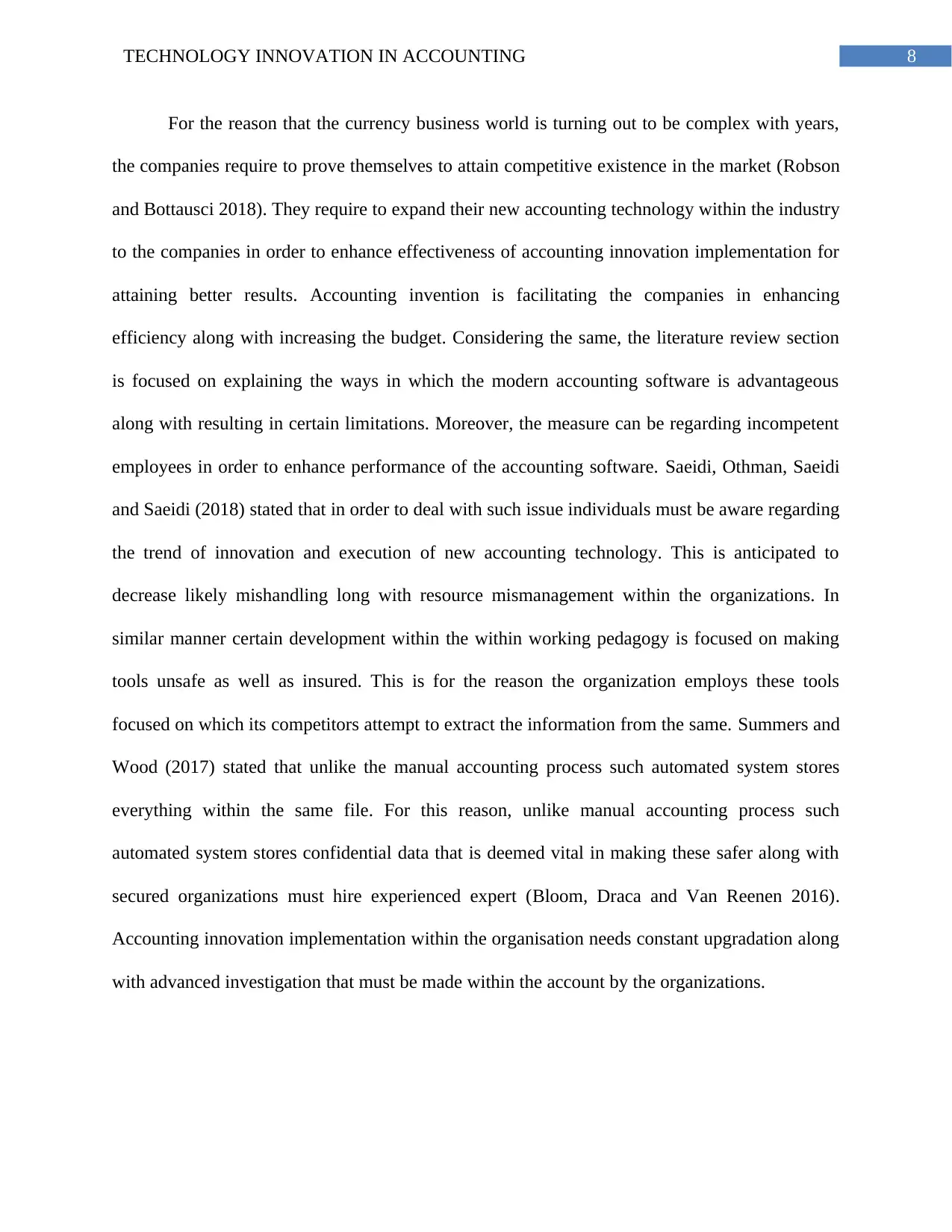
8TECHNOLOGY INNOVATION IN ACCOUNTING
For the reason that the currency business world is turning out to be complex with years,
the companies require to prove themselves to attain competitive existence in the market (Robson
and Bottausci 2018). They require to expand their new accounting technology within the industry
to the companies in order to enhance effectiveness of accounting innovation implementation for
attaining better results. Accounting invention is facilitating the companies in enhancing
efficiency along with increasing the budget. Considering the same, the literature review section
is focused on explaining the ways in which the modern accounting software is advantageous
along with resulting in certain limitations. Moreover, the measure can be regarding incompetent
employees in order to enhance performance of the accounting software. Saeidi, Othman, Saeidi
and Saeidi (2018) stated that in order to deal with such issue individuals must be aware regarding
the trend of innovation and execution of new accounting technology. This is anticipated to
decrease likely mishandling long with resource mismanagement within the organizations. In
similar manner certain development within the within working pedagogy is focused on making
tools unsafe as well as insured. This is for the reason the organization employs these tools
focused on which its competitors attempt to extract the information from the same. Summers and
Wood (2017) stated that unlike the manual accounting process such automated system stores
everything within the same file. For this reason, unlike manual accounting process such
automated system stores confidential data that is deemed vital in making these safer along with
secured organizations must hire experienced expert (Bloom, Draca and Van Reenen 2016).
Accounting innovation implementation within the organisation needs constant upgradation along
with advanced investigation that must be made within the account by the organizations.
For the reason that the currency business world is turning out to be complex with years,
the companies require to prove themselves to attain competitive existence in the market (Robson
and Bottausci 2018). They require to expand their new accounting technology within the industry
to the companies in order to enhance effectiveness of accounting innovation implementation for
attaining better results. Accounting invention is facilitating the companies in enhancing
efficiency along with increasing the budget. Considering the same, the literature review section
is focused on explaining the ways in which the modern accounting software is advantageous
along with resulting in certain limitations. Moreover, the measure can be regarding incompetent
employees in order to enhance performance of the accounting software. Saeidi, Othman, Saeidi
and Saeidi (2018) stated that in order to deal with such issue individuals must be aware regarding
the trend of innovation and execution of new accounting technology. This is anticipated to
decrease likely mishandling long with resource mismanagement within the organizations. In
similar manner certain development within the within working pedagogy is focused on making
tools unsafe as well as insured. This is for the reason the organization employs these tools
focused on which its competitors attempt to extract the information from the same. Summers and
Wood (2017) stated that unlike the manual accounting process such automated system stores
everything within the same file. For this reason, unlike manual accounting process such
automated system stores confidential data that is deemed vital in making these safer along with
secured organizations must hire experienced expert (Bloom, Draca and Van Reenen 2016).
Accounting innovation implementation within the organisation needs constant upgradation along
with advanced investigation that must be made within the account by the organizations.
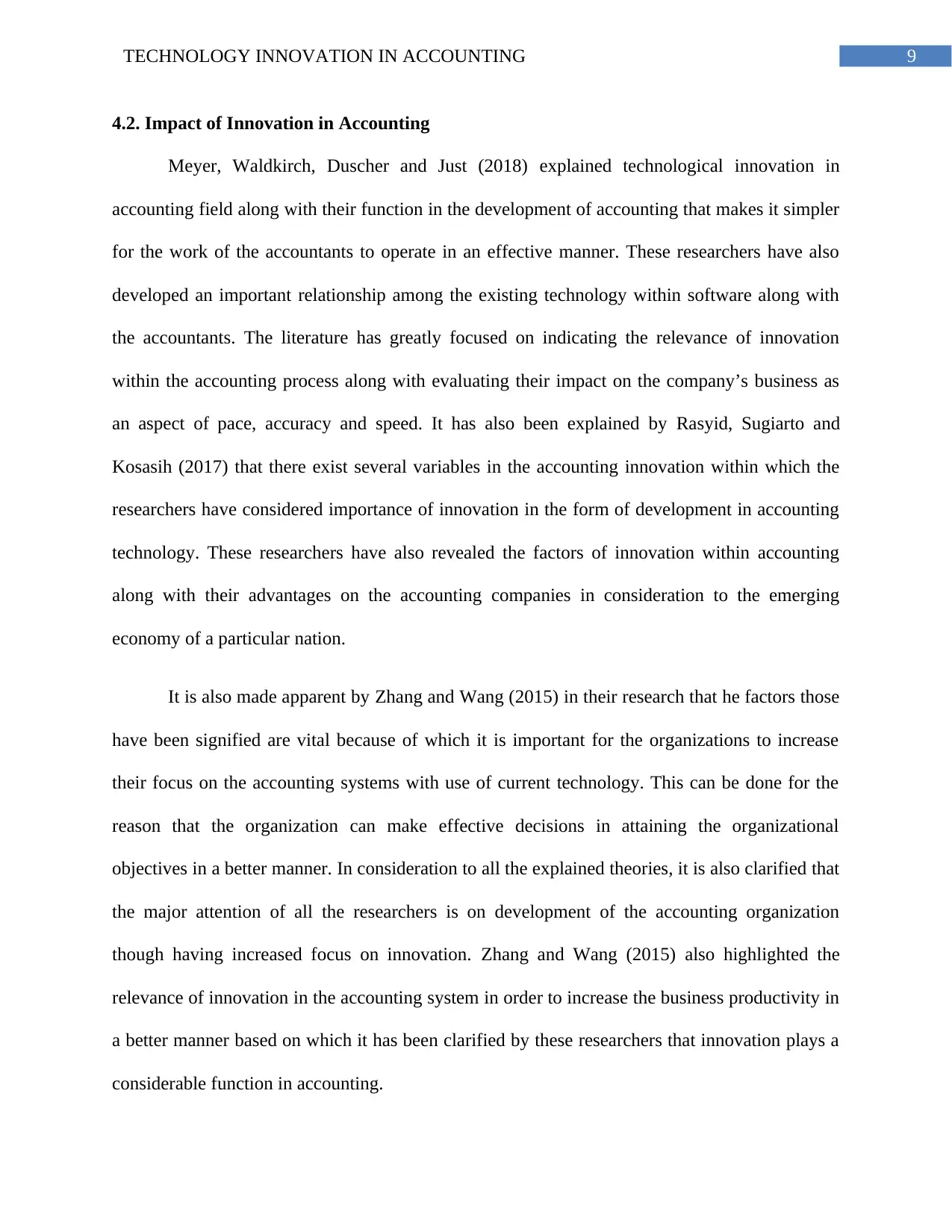
9TECHNOLOGY INNOVATION IN ACCOUNTING
4.2. Impact of Innovation in Accounting
Meyer, Waldkirch, Duscher and Just (2018) explained technological innovation in
accounting field along with their function in the development of accounting that makes it simpler
for the work of the accountants to operate in an effective manner. These researchers have also
developed an important relationship among the existing technology within software along with
the accountants. The literature has greatly focused on indicating the relevance of innovation
within the accounting process along with evaluating their impact on the company’s business as
an aspect of pace, accuracy and speed. It has also been explained by Rasyid, Sugiarto and
Kosasih (2017) that there exist several variables in the accounting innovation within which the
researchers have considered importance of innovation in the form of development in accounting
technology. These researchers have also revealed the factors of innovation within accounting
along with their advantages on the accounting companies in consideration to the emerging
economy of a particular nation.
It is also made apparent by Zhang and Wang (2015) in their research that he factors those
have been signified are vital because of which it is important for the organizations to increase
their focus on the accounting systems with use of current technology. This can be done for the
reason that the organization can make effective decisions in attaining the organizational
objectives in a better manner. In consideration to all the explained theories, it is also clarified that
the major attention of all the researchers is on development of the accounting organization
though having increased focus on innovation. Zhang and Wang (2015) also highlighted the
relevance of innovation in the accounting system in order to increase the business productivity in
a better manner based on which it has been clarified by these researchers that innovation plays a
considerable function in accounting.
4.2. Impact of Innovation in Accounting
Meyer, Waldkirch, Duscher and Just (2018) explained technological innovation in
accounting field along with their function in the development of accounting that makes it simpler
for the work of the accountants to operate in an effective manner. These researchers have also
developed an important relationship among the existing technology within software along with
the accountants. The literature has greatly focused on indicating the relevance of innovation
within the accounting process along with evaluating their impact on the company’s business as
an aspect of pace, accuracy and speed. It has also been explained by Rasyid, Sugiarto and
Kosasih (2017) that there exist several variables in the accounting innovation within which the
researchers have considered importance of innovation in the form of development in accounting
technology. These researchers have also revealed the factors of innovation within accounting
along with their advantages on the accounting companies in consideration to the emerging
economy of a particular nation.
It is also made apparent by Zhang and Wang (2015) in their research that he factors those
have been signified are vital because of which it is important for the organizations to increase
their focus on the accounting systems with use of current technology. This can be done for the
reason that the organization can make effective decisions in attaining the organizational
objectives in a better manner. In consideration to all the explained theories, it is also clarified that
the major attention of all the researchers is on development of the accounting organization
though having increased focus on innovation. Zhang and Wang (2015) also highlighted the
relevance of innovation in the accounting system in order to increase the business productivity in
a better manner based on which it has been clarified by these researchers that innovation plays a
considerable function in accounting.
Secure Best Marks with AI Grader
Need help grading? Try our AI Grader for instant feedback on your assignments.
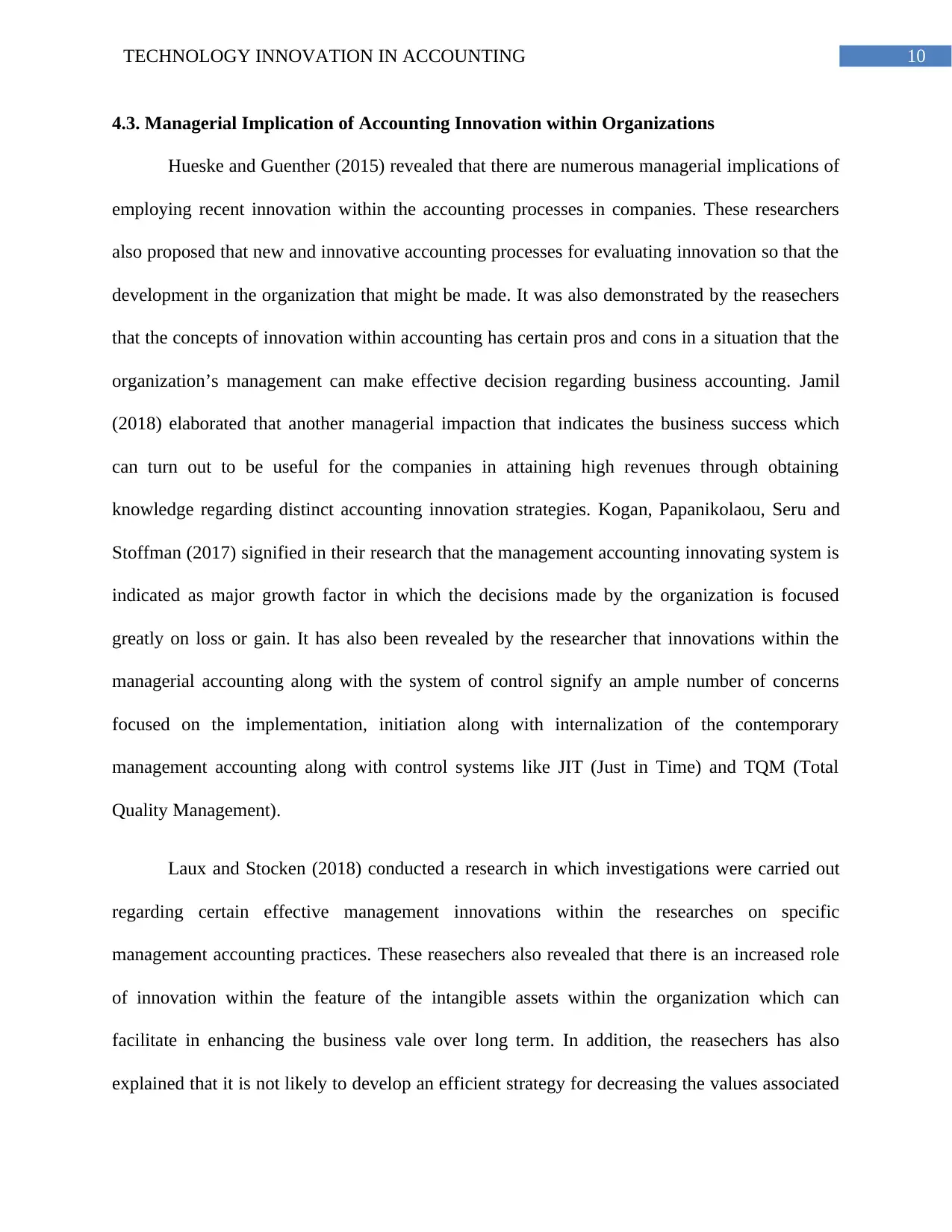
10TECHNOLOGY INNOVATION IN ACCOUNTING
4.3. Managerial Implication of Accounting Innovation within Organizations
Hueske and Guenther (2015) revealed that there are numerous managerial implications of
employing recent innovation within the accounting processes in companies. These researchers
also proposed that new and innovative accounting processes for evaluating innovation so that the
development in the organization that might be made. It was also demonstrated by the reasechers
that the concepts of innovation within accounting has certain pros and cons in a situation that the
organization’s management can make effective decision regarding business accounting. Jamil
(2018) elaborated that another managerial impaction that indicates the business success which
can turn out to be useful for the companies in attaining high revenues through obtaining
knowledge regarding distinct accounting innovation strategies. Kogan, Papanikolaou, Seru and
Stoffman (2017) signified in their research that the management accounting innovating system is
indicated as major growth factor in which the decisions made by the organization is focused
greatly on loss or gain. It has also been revealed by the researcher that innovations within the
managerial accounting along with the system of control signify an ample number of concerns
focused on the implementation, initiation along with internalization of the contemporary
management accounting along with control systems like JIT (Just in Time) and TQM (Total
Quality Management).
Laux and Stocken (2018) conducted a research in which investigations were carried out
regarding certain effective management innovations within the researches on specific
management accounting practices. These reasechers also revealed that there is an increased role
of innovation within the feature of the intangible assets within the organization which can
facilitate in enhancing the business vale over long term. In addition, the reasechers has also
explained that it is not likely to develop an efficient strategy for decreasing the values associated
4.3. Managerial Implication of Accounting Innovation within Organizations
Hueske and Guenther (2015) revealed that there are numerous managerial implications of
employing recent innovation within the accounting processes in companies. These researchers
also proposed that new and innovative accounting processes for evaluating innovation so that the
development in the organization that might be made. It was also demonstrated by the reasechers
that the concepts of innovation within accounting has certain pros and cons in a situation that the
organization’s management can make effective decision regarding business accounting. Jamil
(2018) elaborated that another managerial impaction that indicates the business success which
can turn out to be useful for the companies in attaining high revenues through obtaining
knowledge regarding distinct accounting innovation strategies. Kogan, Papanikolaou, Seru and
Stoffman (2017) signified in their research that the management accounting innovating system is
indicated as major growth factor in which the decisions made by the organization is focused
greatly on loss or gain. It has also been revealed by the researcher that innovations within the
managerial accounting along with the system of control signify an ample number of concerns
focused on the implementation, initiation along with internalization of the contemporary
management accounting along with control systems like JIT (Just in Time) and TQM (Total
Quality Management).
Laux and Stocken (2018) conducted a research in which investigations were carried out
regarding certain effective management innovations within the researches on specific
management accounting practices. These reasechers also revealed that there is an increased role
of innovation within the feature of the intangible assets within the organization which can
facilitate in enhancing the business vale over long term. In addition, the reasechers has also
explained that it is not likely to develop an efficient strategy for decreasing the values associated
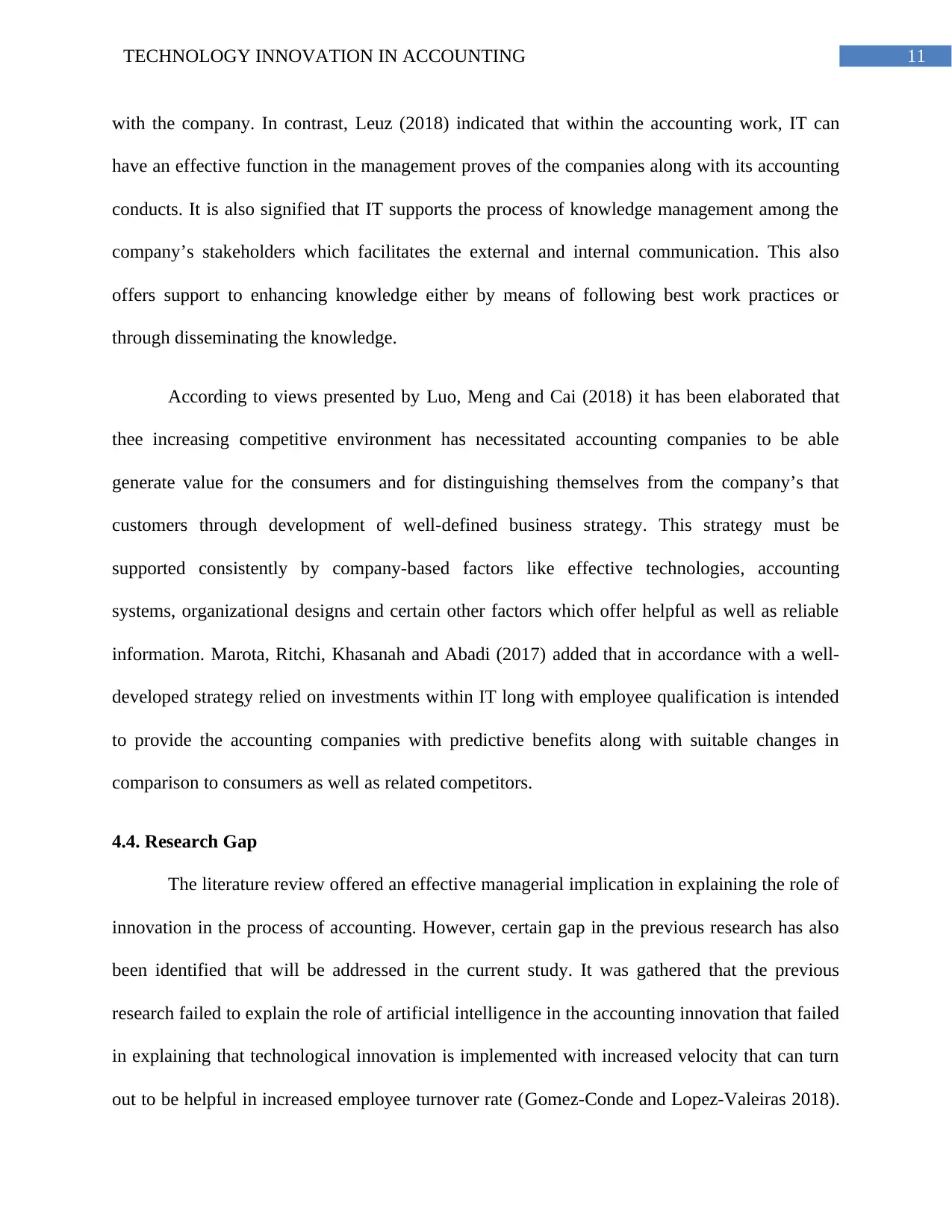
11TECHNOLOGY INNOVATION IN ACCOUNTING
with the company. In contrast, Leuz (2018) indicated that within the accounting work, IT can
have an effective function in the management proves of the companies along with its accounting
conducts. It is also signified that IT supports the process of knowledge management among the
company’s stakeholders which facilitates the external and internal communication. This also
offers support to enhancing knowledge either by means of following best work practices or
through disseminating the knowledge.
According to views presented by Luo, Meng and Cai (2018) it has been elaborated that
thee increasing competitive environment has necessitated accounting companies to be able
generate value for the consumers and for distinguishing themselves from the company’s that
customers through development of well-defined business strategy. This strategy must be
supported consistently by company-based factors like effective technologies, accounting
systems, organizational designs and certain other factors which offer helpful as well as reliable
information. Marota, Ritchi, Khasanah and Abadi (2017) added that in accordance with a well-
developed strategy relied on investments within IT long with employee qualification is intended
to provide the accounting companies with predictive benefits along with suitable changes in
comparison to consumers as well as related competitors.
4.4. Research Gap
The literature review offered an effective managerial implication in explaining the role of
innovation in the process of accounting. However, certain gap in the previous research has also
been identified that will be addressed in the current study. It was gathered that the previous
research failed to explain the role of artificial intelligence in the accounting innovation that failed
in explaining that technological innovation is implemented with increased velocity that can turn
out to be helpful in increased employee turnover rate (Gomez-Conde and Lopez-Valeiras 2018).
with the company. In contrast, Leuz (2018) indicated that within the accounting work, IT can
have an effective function in the management proves of the companies along with its accounting
conducts. It is also signified that IT supports the process of knowledge management among the
company’s stakeholders which facilitates the external and internal communication. This also
offers support to enhancing knowledge either by means of following best work practices or
through disseminating the knowledge.
According to views presented by Luo, Meng and Cai (2018) it has been elaborated that
thee increasing competitive environment has necessitated accounting companies to be able
generate value for the consumers and for distinguishing themselves from the company’s that
customers through development of well-defined business strategy. This strategy must be
supported consistently by company-based factors like effective technologies, accounting
systems, organizational designs and certain other factors which offer helpful as well as reliable
information. Marota, Ritchi, Khasanah and Abadi (2017) added that in accordance with a well-
developed strategy relied on investments within IT long with employee qualification is intended
to provide the accounting companies with predictive benefits along with suitable changes in
comparison to consumers as well as related competitors.
4.4. Research Gap
The literature review offered an effective managerial implication in explaining the role of
innovation in the process of accounting. However, certain gap in the previous research has also
been identified that will be addressed in the current study. It was gathered that the previous
research failed to explain the role of artificial intelligence in the accounting innovation that failed
in explaining that technological innovation is implemented with increased velocity that can turn
out to be helpful in increased employee turnover rate (Gomez-Conde and Lopez-Valeiras 2018).
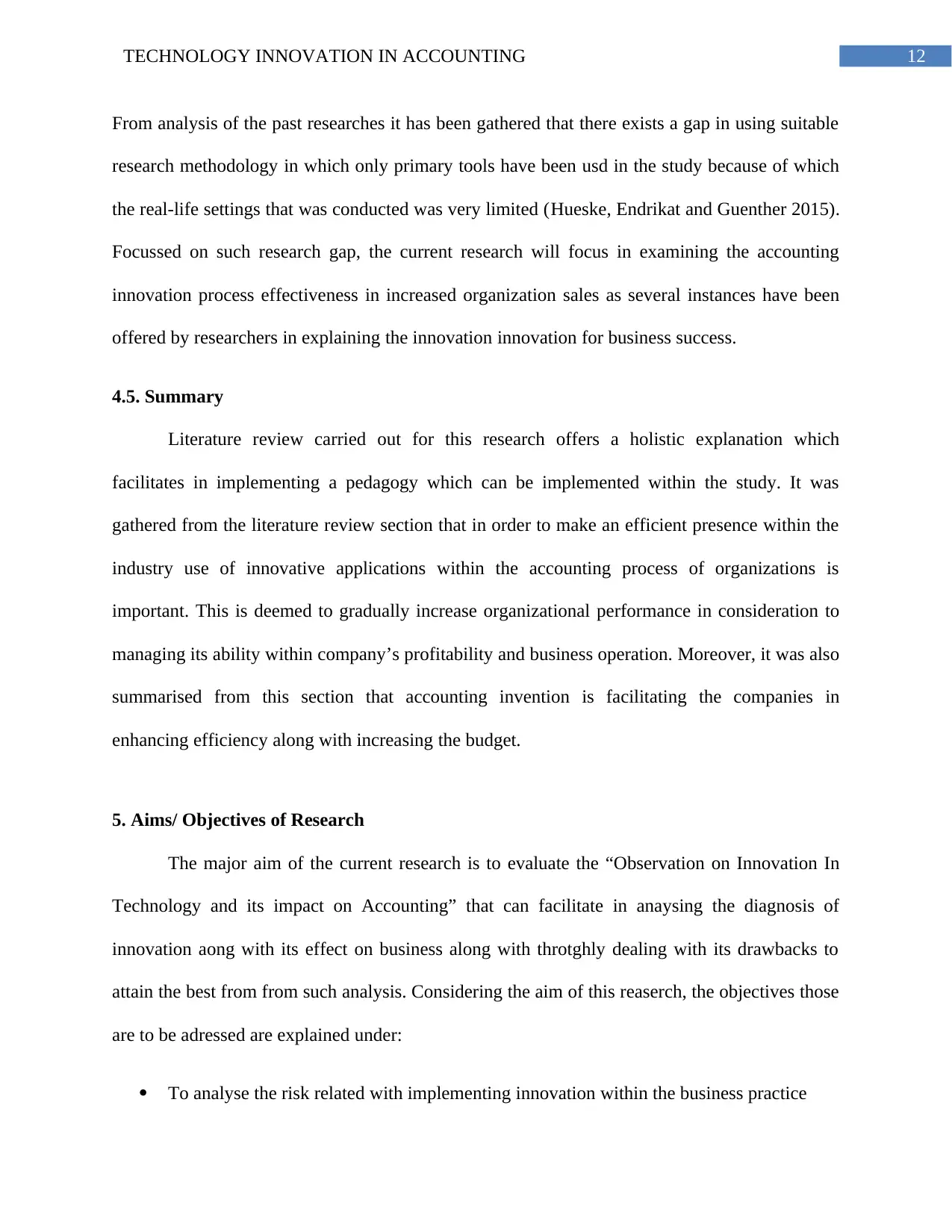
12TECHNOLOGY INNOVATION IN ACCOUNTING
From analysis of the past researches it has been gathered that there exists a gap in using suitable
research methodology in which only primary tools have been usd in the study because of which
the real-life settings that was conducted was very limited (Hueske, Endrikat and Guenther 2015).
Focussed on such research gap, the current research will focus in examining the accounting
innovation process effectiveness in increased organization sales as several instances have been
offered by researchers in explaining the innovation innovation for business success.
4.5. Summary
Literature review carried out for this research offers a holistic explanation which
facilitates in implementing a pedagogy which can be implemented within the study. It was
gathered from the literature review section that in order to make an efficient presence within the
industry use of innovative applications within the accounting process of organizations is
important. This is deemed to gradually increase organizational performance in consideration to
managing its ability within company’s profitability and business operation. Moreover, it was also
summarised from this section that accounting invention is facilitating the companies in
enhancing efficiency along with increasing the budget.
5. Aims/ Objectives of Research
The major aim of the current research is to evaluate the “Observation on Innovation In
Technology and its impact on Accounting” that can facilitate in anaysing the diagnosis of
innovation aong with its effect on business along with throtghly dealing with its drawbacks to
attain the best from from such analysis. Considering the aim of this reaserch, the objectives those
are to be adressed are explained under:
To analyse the risk related with implementing innovation within the business practice
From analysis of the past researches it has been gathered that there exists a gap in using suitable
research methodology in which only primary tools have been usd in the study because of which
the real-life settings that was conducted was very limited (Hueske, Endrikat and Guenther 2015).
Focussed on such research gap, the current research will focus in examining the accounting
innovation process effectiveness in increased organization sales as several instances have been
offered by researchers in explaining the innovation innovation for business success.
4.5. Summary
Literature review carried out for this research offers a holistic explanation which
facilitates in implementing a pedagogy which can be implemented within the study. It was
gathered from the literature review section that in order to make an efficient presence within the
industry use of innovative applications within the accounting process of organizations is
important. This is deemed to gradually increase organizational performance in consideration to
managing its ability within company’s profitability and business operation. Moreover, it was also
summarised from this section that accounting invention is facilitating the companies in
enhancing efficiency along with increasing the budget.
5. Aims/ Objectives of Research
The major aim of the current research is to evaluate the “Observation on Innovation In
Technology and its impact on Accounting” that can facilitate in anaysing the diagnosis of
innovation aong with its effect on business along with throtghly dealing with its drawbacks to
attain the best from from such analysis. Considering the aim of this reaserch, the objectives those
are to be adressed are explained under:
To analyse the risk related with implementing innovation within the business practice
Paraphrase This Document
Need a fresh take? Get an instant paraphrase of this document with our AI Paraphraser

13TECHNOLOGY INNOVATION IN ACCOUNTING
To evaluate the uncertainty related with implementing innovation within the business
practice
To deal with the limitations revealed the research to attain best findings from the study
6. Research Design or Methodology
6.1. Introduction
In the research methodology section, the researcher has centred in evaluating the manner
in which research methods can be employed in gathering suitable research results. The intention
of this section is to elaborate most suitable research methodology that can be employed in
evaluating the role of innovation in improving accounting process in companies (Benny 2015).
In account for the same, the section of research methodology will explain suitable study
approach, philosophy, process of data collection, study design, plan of data analysis along with
reliability and validity of collected data. Employing suitable research techniques in the research
can facilitate in attaining suitable study findings on effective use of accounting technology for
enhancing business operations.
6.2. Philosophy of Research
Choosing most appropriate research philosophy is important for the researcher in
analysing the importance of the current study through using suitable research paradigm.
Interpretivism, realism and positivism are three major types of research philosophies employed
within the study. The current research focuses on analysing the role of accounting innovation in
enhancing business operations all over Australia (Becker, Wald, Gessner and Gleich 2015). For
such causes, the recent study has considered making an enhanced attempt in analysing the
challenges faced by Australian organizations in implementing recent technology within its
To evaluate the uncertainty related with implementing innovation within the business
practice
To deal with the limitations revealed the research to attain best findings from the study
6. Research Design or Methodology
6.1. Introduction
In the research methodology section, the researcher has centred in evaluating the manner
in which research methods can be employed in gathering suitable research results. The intention
of this section is to elaborate most suitable research methodology that can be employed in
evaluating the role of innovation in improving accounting process in companies (Benny 2015).
In account for the same, the section of research methodology will explain suitable study
approach, philosophy, process of data collection, study design, plan of data analysis along with
reliability and validity of collected data. Employing suitable research techniques in the research
can facilitate in attaining suitable study findings on effective use of accounting technology for
enhancing business operations.
6.2. Philosophy of Research
Choosing most appropriate research philosophy is important for the researcher in
analysing the importance of the current study through using suitable research paradigm.
Interpretivism, realism and positivism are three major types of research philosophies employed
within the study. The current research focuses on analysing the role of accounting innovation in
enhancing business operations all over Australia (Becker, Wald, Gessner and Gleich 2015). For
such causes, the recent study has considered making an enhanced attempt in analysing the
challenges faced by Australian organizations in implementing recent technology within its

14TECHNOLOGY INNOVATION IN ACCOUNTING
accounting operations. Considering the subject of the research, the current study will consider
implementing the philosophy of positivism by linking the theories and models explained in the
literature review section along with the research background section (Bedford 2015). Use of the
selected research philosophy is considered suitable in this study as it can facilitate in attaining
reliable respondents from the survey responses. Moreover, use of the interpretivism and realism
philosophy was not considered for this study as they are not linked with scientifically proven
models and theories.
6.3. Approach of Research
Research approach is deemed being a vital technique in conducting research for obtaining
preferable and reliable research findings. In account for the same, selecting suitable research
approach supports the researcher in analysing all the steps for conducting desisted activities
(Bloom, Draca and Van Reenen 2016). Research approaches can be of two types such an
inductive and deductive which facilitates in obtaining reliable research outcomes. The current
research approach centres on analysing the impact of innovation in accounting and its
implications on accounting functions of Australian busineses. Considering such aim, the
researcher will implement deductive research approach because it aligns with positivism research
philosophy in attaining constructive research results. Quantitative research analysis is carried out
for the study by evaluating the responses gathered from the target survey respondents. In
addition, research philosophy of positivism is directly linked with quantitative data evaluation
for which important data was gathered and evaluated through use of existing trends and models
along with proven facts (Busco and Quattrone 2018). This is the cause for which deductive
research approach can serve to be highly important in obtaining important implications for this
exploration.
accounting operations. Considering the subject of the research, the current study will consider
implementing the philosophy of positivism by linking the theories and models explained in the
literature review section along with the research background section (Bedford 2015). Use of the
selected research philosophy is considered suitable in this study as it can facilitate in attaining
reliable respondents from the survey responses. Moreover, use of the interpretivism and realism
philosophy was not considered for this study as they are not linked with scientifically proven
models and theories.
6.3. Approach of Research
Research approach is deemed being a vital technique in conducting research for obtaining
preferable and reliable research findings. In account for the same, selecting suitable research
approach supports the researcher in analysing all the steps for conducting desisted activities
(Bloom, Draca and Van Reenen 2016). Research approaches can be of two types such an
inductive and deductive which facilitates in obtaining reliable research outcomes. The current
research approach centres on analysing the impact of innovation in accounting and its
implications on accounting functions of Australian busineses. Considering such aim, the
researcher will implement deductive research approach because it aligns with positivism research
philosophy in attaining constructive research results. Quantitative research analysis is carried out
for the study by evaluating the responses gathered from the target survey respondents. In
addition, research philosophy of positivism is directly linked with quantitative data evaluation
for which important data was gathered and evaluated through use of existing trends and models
along with proven facts (Busco and Quattrone 2018). This is the cause for which deductive
research approach can serve to be highly important in obtaining important implications for this
exploration.
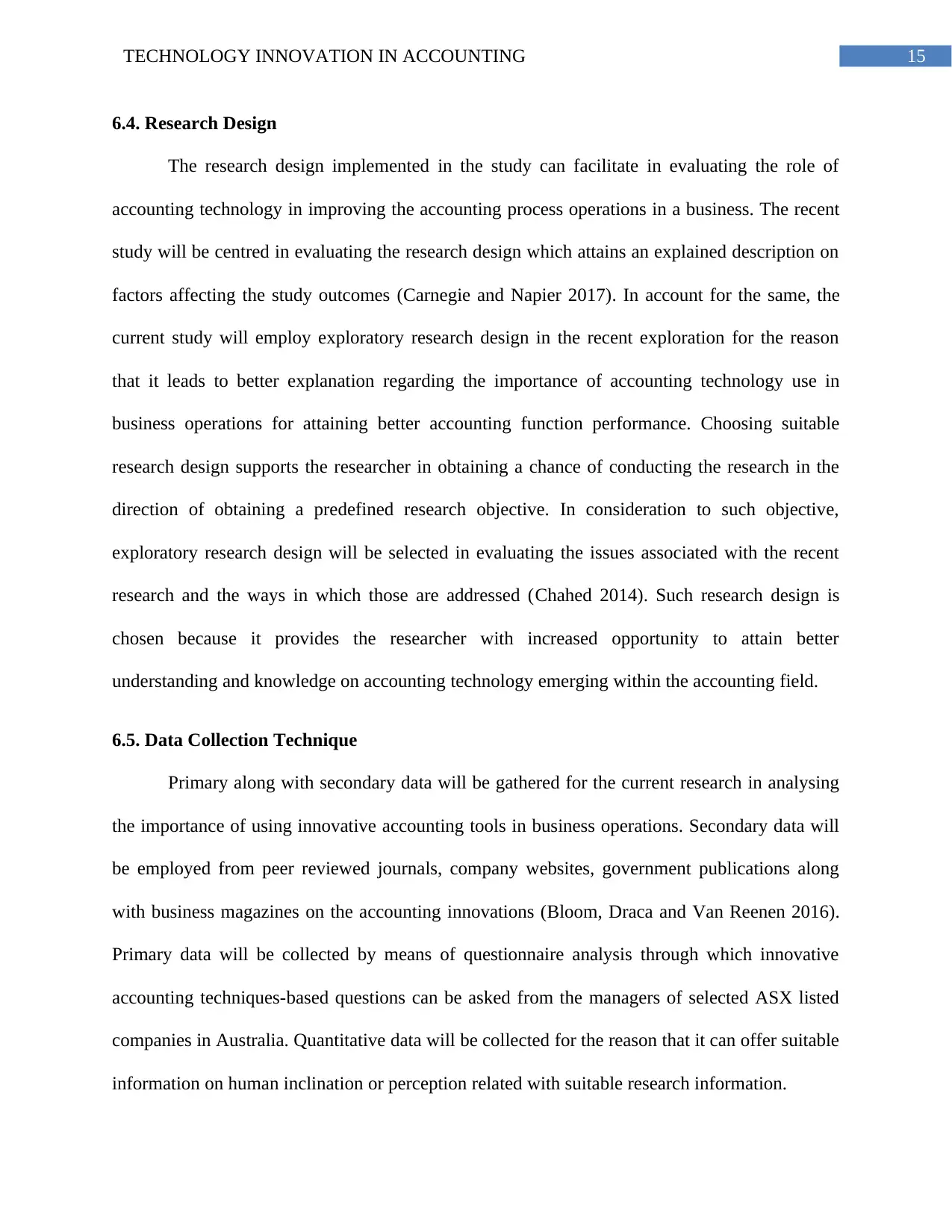
15TECHNOLOGY INNOVATION IN ACCOUNTING
6.4. Research Design
The research design implemented in the study can facilitate in evaluating the role of
accounting technology in improving the accounting process operations in a business. The recent
study will be centred in evaluating the research design which attains an explained description on
factors affecting the study outcomes (Carnegie and Napier 2017). In account for the same, the
current study will employ exploratory research design in the recent exploration for the reason
that it leads to better explanation regarding the importance of accounting technology use in
business operations for attaining better accounting function performance. Choosing suitable
research design supports the researcher in obtaining a chance of conducting the research in the
direction of obtaining a predefined research objective. In consideration to such objective,
exploratory research design will be selected in evaluating the issues associated with the recent
research and the ways in which those are addressed (Chahed 2014). Such research design is
chosen because it provides the researcher with increased opportunity to attain better
understanding and knowledge on accounting technology emerging within the accounting field.
6.5. Data Collection Technique
Primary along with secondary data will be gathered for the current research in analysing
the importance of using innovative accounting tools in business operations. Secondary data will
be employed from peer reviewed journals, company websites, government publications along
with business magazines on the accounting innovations (Bloom, Draca and Van Reenen 2016).
Primary data will be collected by means of questionnaire analysis through which innovative
accounting techniques-based questions can be asked from the managers of selected ASX listed
companies in Australia. Quantitative data will be collected for the reason that it can offer suitable
information on human inclination or perception related with suitable research information.
6.4. Research Design
The research design implemented in the study can facilitate in evaluating the role of
accounting technology in improving the accounting process operations in a business. The recent
study will be centred in evaluating the research design which attains an explained description on
factors affecting the study outcomes (Carnegie and Napier 2017). In account for the same, the
current study will employ exploratory research design in the recent exploration for the reason
that it leads to better explanation regarding the importance of accounting technology use in
business operations for attaining better accounting function performance. Choosing suitable
research design supports the researcher in obtaining a chance of conducting the research in the
direction of obtaining a predefined research objective. In consideration to such objective,
exploratory research design will be selected in evaluating the issues associated with the recent
research and the ways in which those are addressed (Chahed 2014). Such research design is
chosen because it provides the researcher with increased opportunity to attain better
understanding and knowledge on accounting technology emerging within the accounting field.
6.5. Data Collection Technique
Primary along with secondary data will be gathered for the current research in analysing
the importance of using innovative accounting tools in business operations. Secondary data will
be employed from peer reviewed journals, company websites, government publications along
with business magazines on the accounting innovations (Bloom, Draca and Van Reenen 2016).
Primary data will be collected by means of questionnaire analysis through which innovative
accounting techniques-based questions can be asked from the managers of selected ASX listed
companies in Australia. Quantitative data will be collected for the reason that it can offer suitable
information on human inclination or perception related with suitable research information.
Secure Best Marks with AI Grader
Need help grading? Try our AI Grader for instant feedback on your assignments.
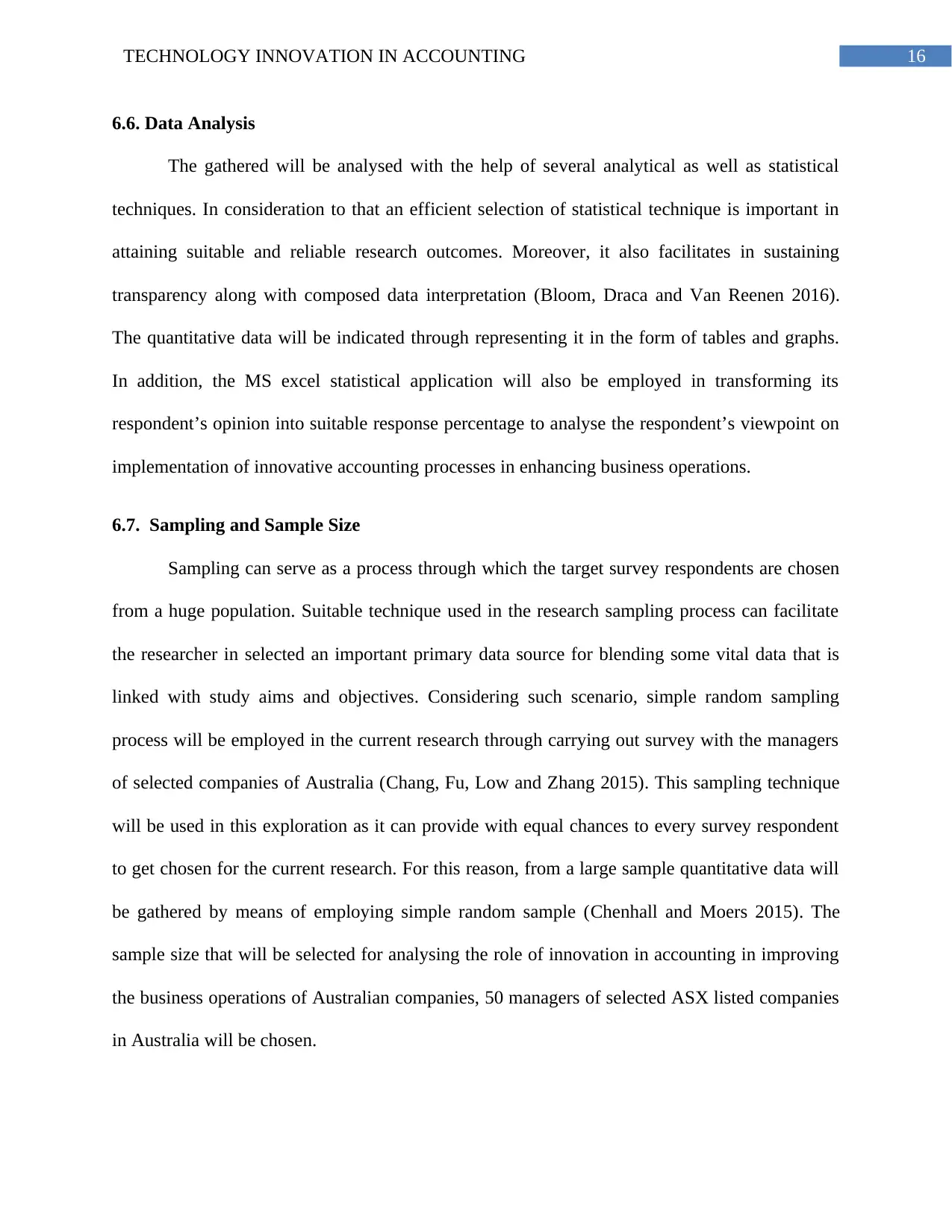
16TECHNOLOGY INNOVATION IN ACCOUNTING
6.6. Data Analysis
The gathered will be analysed with the help of several analytical as well as statistical
techniques. In consideration to that an efficient selection of statistical technique is important in
attaining suitable and reliable research outcomes. Moreover, it also facilitates in sustaining
transparency along with composed data interpretation (Bloom, Draca and Van Reenen 2016).
The quantitative data will be indicated through representing it in the form of tables and graphs.
In addition, the MS excel statistical application will also be employed in transforming its
respondent’s opinion into suitable response percentage to analyse the respondent’s viewpoint on
implementation of innovative accounting processes in enhancing business operations.
6.7. Sampling and Sample Size
Sampling can serve as a process through which the target survey respondents are chosen
from a huge population. Suitable technique used in the research sampling process can facilitate
the researcher in selected an important primary data source for blending some vital data that is
linked with study aims and objectives. Considering such scenario, simple random sampling
process will be employed in the current research through carrying out survey with the managers
of selected companies of Australia (Chang, Fu, Low and Zhang 2015). This sampling technique
will be used in this exploration as it can provide with equal chances to every survey respondent
to get chosen for the current research. For this reason, from a large sample quantitative data will
be gathered by means of employing simple random sample (Chenhall and Moers 2015). The
sample size that will be selected for analysing the role of innovation in accounting in improving
the business operations of Australian companies, 50 managers of selected ASX listed companies
in Australia will be chosen.
6.6. Data Analysis
The gathered will be analysed with the help of several analytical as well as statistical
techniques. In consideration to that an efficient selection of statistical technique is important in
attaining suitable and reliable research outcomes. Moreover, it also facilitates in sustaining
transparency along with composed data interpretation (Bloom, Draca and Van Reenen 2016).
The quantitative data will be indicated through representing it in the form of tables and graphs.
In addition, the MS excel statistical application will also be employed in transforming its
respondent’s opinion into suitable response percentage to analyse the respondent’s viewpoint on
implementation of innovative accounting processes in enhancing business operations.
6.7. Sampling and Sample Size
Sampling can serve as a process through which the target survey respondents are chosen
from a huge population. Suitable technique used in the research sampling process can facilitate
the researcher in selected an important primary data source for blending some vital data that is
linked with study aims and objectives. Considering such scenario, simple random sampling
process will be employed in the current research through carrying out survey with the managers
of selected companies of Australia (Chang, Fu, Low and Zhang 2015). This sampling technique
will be used in this exploration as it can provide with equal chances to every survey respondent
to get chosen for the current research. For this reason, from a large sample quantitative data will
be gathered by means of employing simple random sample (Chenhall and Moers 2015). The
sample size that will be selected for analysing the role of innovation in accounting in improving
the business operations of Australian companies, 50 managers of selected ASX listed companies
in Australia will be chosen.
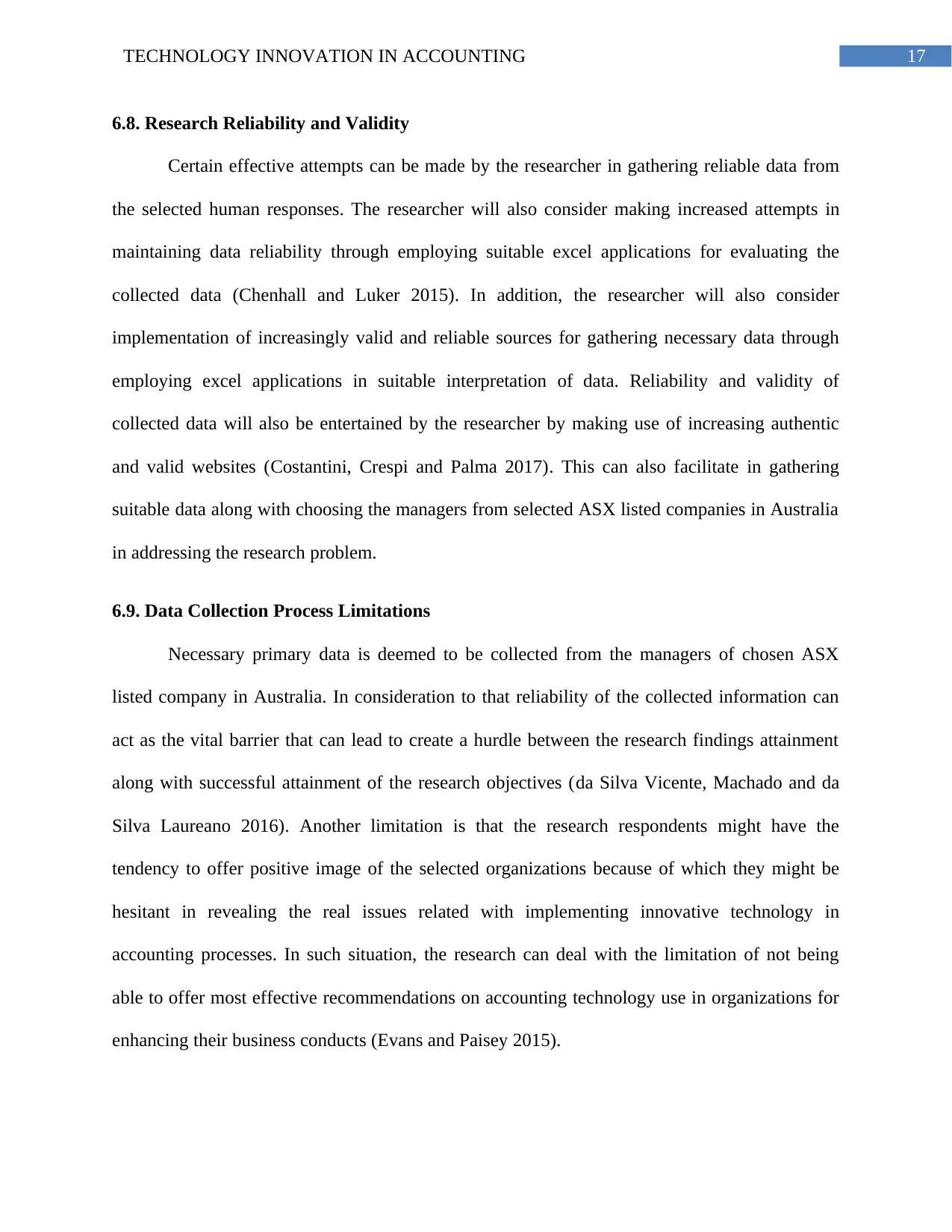
17TECHNOLOGY INNOVATION IN ACCOUNTING
6.8. Research Reliability and Validity
Certain effective attempts can be made by the researcher in gathering reliable data from
the selected human responses. The researcher will also consider making increased attempts in
maintaining data reliability through employing suitable excel applications for evaluating the
collected data (Chenhall and Luker 2015). In addition, the researcher will also consider
implementation of increasingly valid and reliable sources for gathering necessary data through
employing excel applications in suitable interpretation of data. Reliability and validity of
collected data will also be entertained by the researcher by making use of increasing authentic
and valid websites (Costantini, Crespi and Palma 2017). This can also facilitate in gathering
suitable data along with choosing the managers from selected ASX listed companies in Australia
in addressing the research problem.
6.9. Data Collection Process Limitations
Necessary primary data is deemed to be collected from the managers of chosen ASX
listed company in Australia. In consideration to that reliability of the collected information can
act as the vital barrier that can lead to create a hurdle between the research findings attainment
along with successful attainment of the research objectives (da Silva Vicente, Machado and da
Silva Laureano 2016). Another limitation is that the research respondents might have the
tendency to offer positive image of the selected organizations because of which they might be
hesitant in revealing the real issues related with implementing innovative technology in
accounting processes. In such situation, the research can deal with the limitation of not being
able to offer most effective recommendations on accounting technology use in organizations for
enhancing their business conducts (Evans and Paisey 2015).
6.8. Research Reliability and Validity
Certain effective attempts can be made by the researcher in gathering reliable data from
the selected human responses. The researcher will also consider making increased attempts in
maintaining data reliability through employing suitable excel applications for evaluating the
collected data (Chenhall and Luker 2015). In addition, the researcher will also consider
implementation of increasingly valid and reliable sources for gathering necessary data through
employing excel applications in suitable interpretation of data. Reliability and validity of
collected data will also be entertained by the researcher by making use of increasing authentic
and valid websites (Costantini, Crespi and Palma 2017). This can also facilitate in gathering
suitable data along with choosing the managers from selected ASX listed companies in Australia
in addressing the research problem.
6.9. Data Collection Process Limitations
Necessary primary data is deemed to be collected from the managers of chosen ASX
listed company in Australia. In consideration to that reliability of the collected information can
act as the vital barrier that can lead to create a hurdle between the research findings attainment
along with successful attainment of the research objectives (da Silva Vicente, Machado and da
Silva Laureano 2016). Another limitation is that the research respondents might have the
tendency to offer positive image of the selected organizations because of which they might be
hesitant in revealing the real issues related with implementing innovative technology in
accounting processes. In such situation, the research can deal with the limitation of not being
able to offer most effective recommendations on accounting technology use in organizations for
enhancing their business conducts (Evans and Paisey 2015).
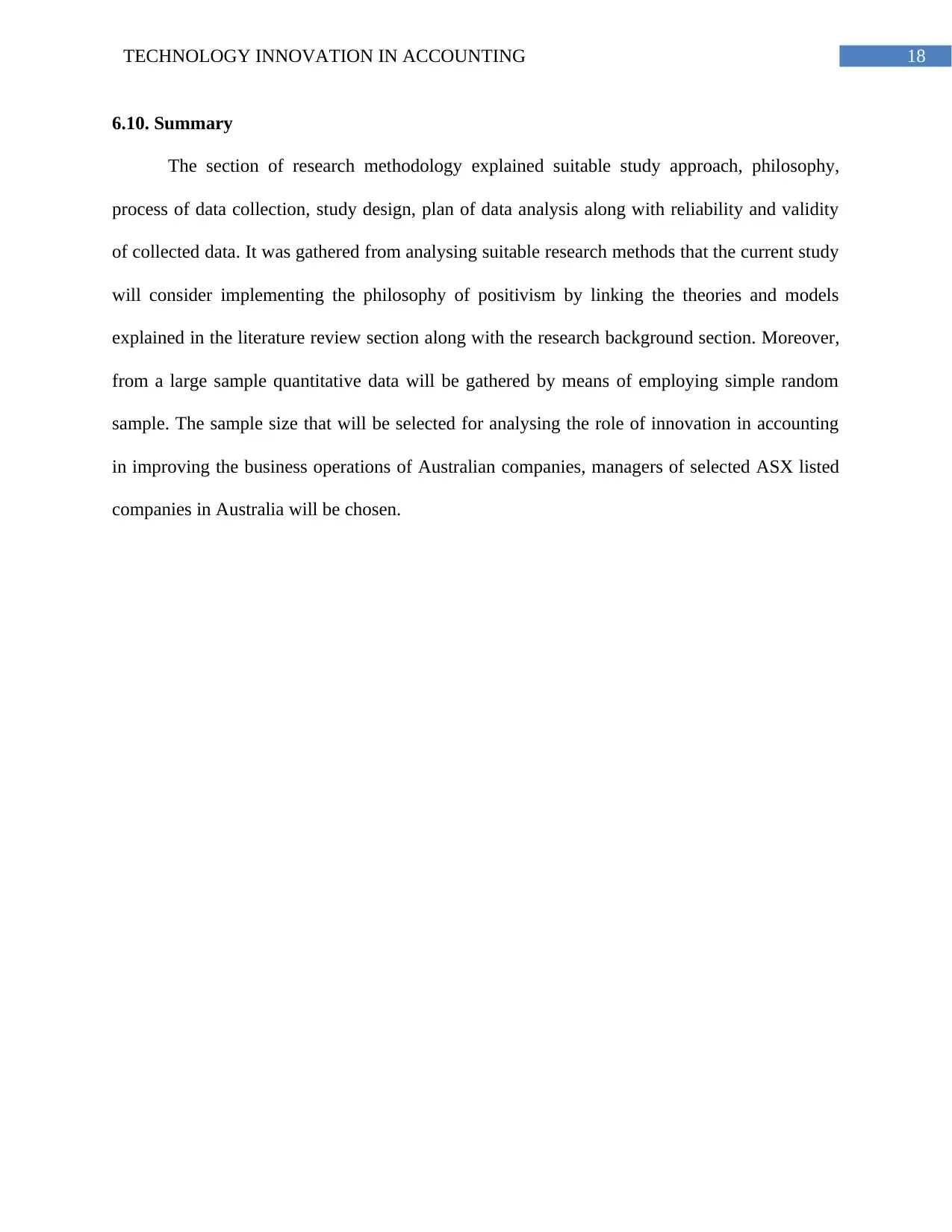
18TECHNOLOGY INNOVATION IN ACCOUNTING
6.10. Summary
The section of research methodology explained suitable study approach, philosophy,
process of data collection, study design, plan of data analysis along with reliability and validity
of collected data. It was gathered from analysing suitable research methods that the current study
will consider implementing the philosophy of positivism by linking the theories and models
explained in the literature review section along with the research background section. Moreover,
from a large sample quantitative data will be gathered by means of employing simple random
sample. The sample size that will be selected for analysing the role of innovation in accounting
in improving the business operations of Australian companies, managers of selected ASX listed
companies in Australia will be chosen.
6.10. Summary
The section of research methodology explained suitable study approach, philosophy,
process of data collection, study design, plan of data analysis along with reliability and validity
of collected data. It was gathered from analysing suitable research methods that the current study
will consider implementing the philosophy of positivism by linking the theories and models
explained in the literature review section along with the research background section. Moreover,
from a large sample quantitative data will be gathered by means of employing simple random
sample. The sample size that will be selected for analysing the role of innovation in accounting
in improving the business operations of Australian companies, managers of selected ASX listed
companies in Australia will be chosen.
Paraphrase This Document
Need a fresh take? Get an instant paraphrase of this document with our AI Paraphraser
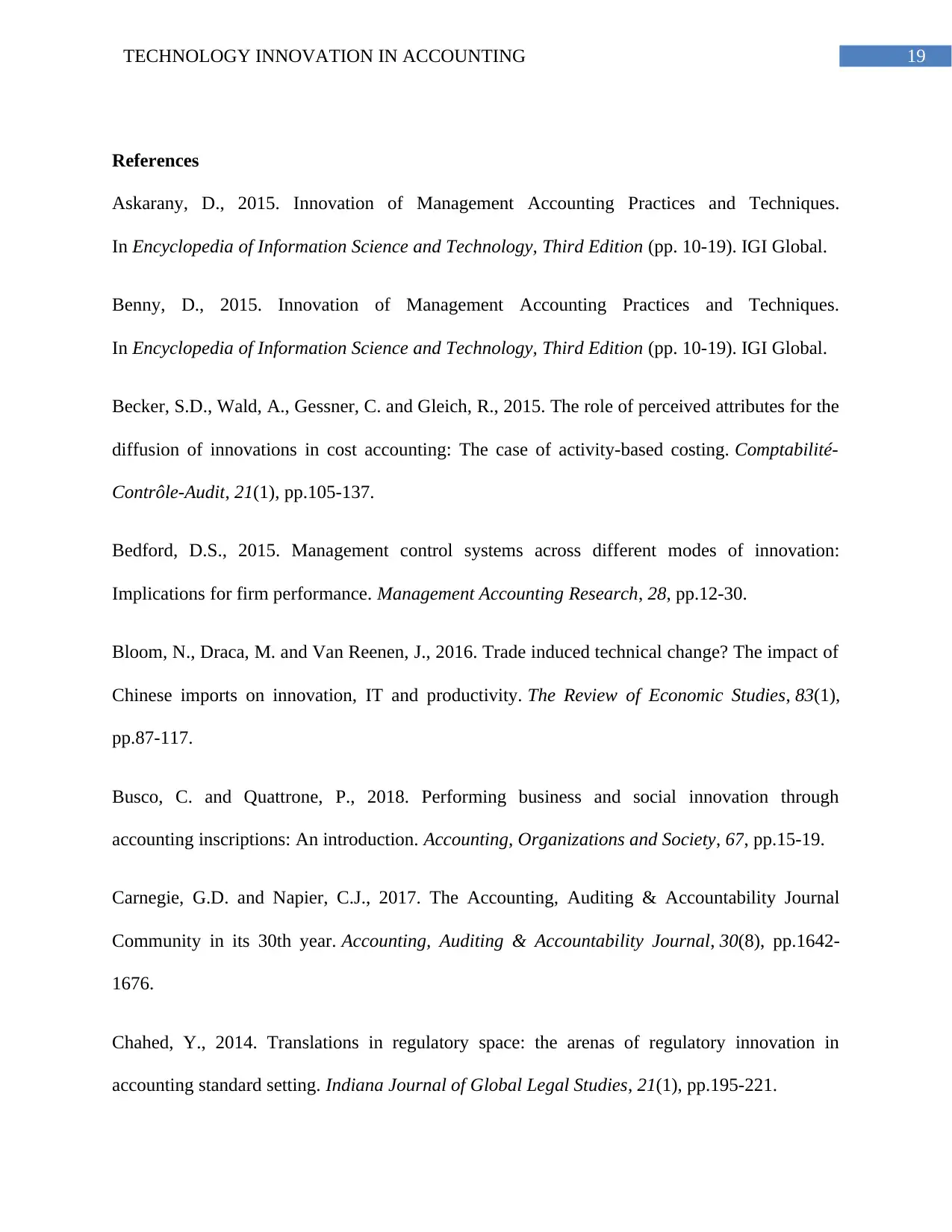
19TECHNOLOGY INNOVATION IN ACCOUNTING
References
Askarany, D., 2015. Innovation of Management Accounting Practices and Techniques.
In Encyclopedia of Information Science and Technology, Third Edition (pp. 10-19). IGI Global.
Benny, D., 2015. Innovation of Management Accounting Practices and Techniques.
In Encyclopedia of Information Science and Technology, Third Edition (pp. 10-19). IGI Global.
Becker, S.D., Wald, A., Gessner, C. and Gleich, R., 2015. The role of perceived attributes for the
diffusion of innovations in cost accounting: The case of activity-based costing. Comptabilité-
Contrôle-Audit, 21(1), pp.105-137.
Bedford, D.S., 2015. Management control systems across different modes of innovation:
Implications for firm performance. Management Accounting Research, 28, pp.12-30.
Bloom, N., Draca, M. and Van Reenen, J., 2016. Trade induced technical change? The impact of
Chinese imports on innovation, IT and productivity. The Review of Economic Studies, 83(1),
pp.87-117.
Busco, C. and Quattrone, P., 2018. Performing business and social innovation through
accounting inscriptions: An introduction. Accounting, Organizations and Society, 67, pp.15-19.
Carnegie, G.D. and Napier, C.J., 2017. The Accounting, Auditing & Accountability Journal
Community in its 30th year. Accounting, Auditing & Accountability Journal, 30(8), pp.1642-
1676.
Chahed, Y., 2014. Translations in regulatory space: the arenas of regulatory innovation in
accounting standard setting. Indiana Journal of Global Legal Studies, 21(1), pp.195-221.
References
Askarany, D., 2015. Innovation of Management Accounting Practices and Techniques.
In Encyclopedia of Information Science and Technology, Third Edition (pp. 10-19). IGI Global.
Benny, D., 2015. Innovation of Management Accounting Practices and Techniques.
In Encyclopedia of Information Science and Technology, Third Edition (pp. 10-19). IGI Global.
Becker, S.D., Wald, A., Gessner, C. and Gleich, R., 2015. The role of perceived attributes for the
diffusion of innovations in cost accounting: The case of activity-based costing. Comptabilité-
Contrôle-Audit, 21(1), pp.105-137.
Bedford, D.S., 2015. Management control systems across different modes of innovation:
Implications for firm performance. Management Accounting Research, 28, pp.12-30.
Bloom, N., Draca, M. and Van Reenen, J., 2016. Trade induced technical change? The impact of
Chinese imports on innovation, IT and productivity. The Review of Economic Studies, 83(1),
pp.87-117.
Busco, C. and Quattrone, P., 2018. Performing business and social innovation through
accounting inscriptions: An introduction. Accounting, Organizations and Society, 67, pp.15-19.
Carnegie, G.D. and Napier, C.J., 2017. The Accounting, Auditing & Accountability Journal
Community in its 30th year. Accounting, Auditing & Accountability Journal, 30(8), pp.1642-
1676.
Chahed, Y., 2014. Translations in regulatory space: the arenas of regulatory innovation in
accounting standard setting. Indiana Journal of Global Legal Studies, 21(1), pp.195-221.
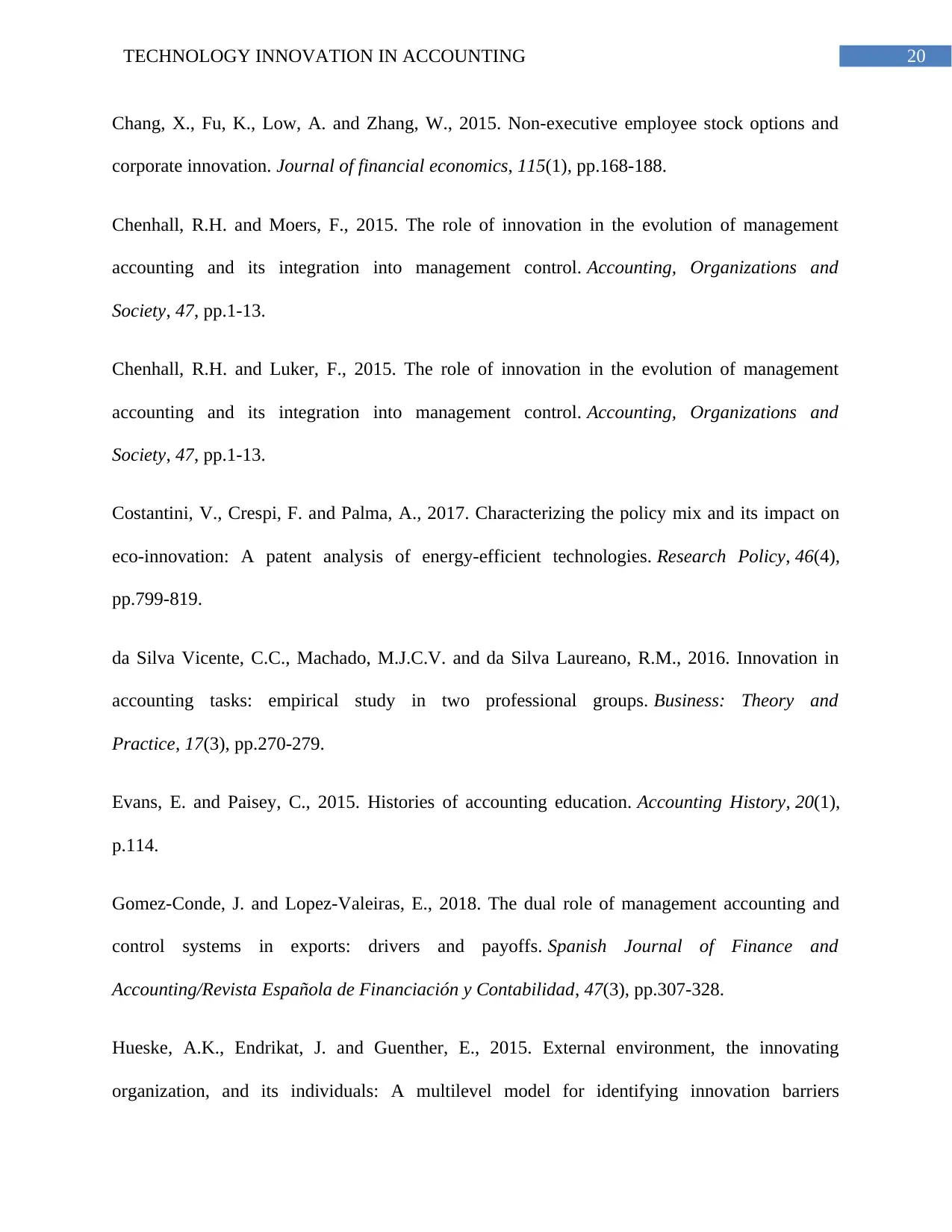
20TECHNOLOGY INNOVATION IN ACCOUNTING
Chang, X., Fu, K., Low, A. and Zhang, W., 2015. Non-executive employee stock options and
corporate innovation. Journal of financial economics, 115(1), pp.168-188.
Chenhall, R.H. and Moers, F., 2015. The role of innovation in the evolution of management
accounting and its integration into management control. Accounting, Organizations and
Society, 47, pp.1-13.
Chenhall, R.H. and Luker, F., 2015. The role of innovation in the evolution of management
accounting and its integration into management control. Accounting, Organizations and
Society, 47, pp.1-13.
Costantini, V., Crespi, F. and Palma, A., 2017. Characterizing the policy mix and its impact on
eco-innovation: A patent analysis of energy-efficient technologies. Research Policy, 46(4),
pp.799-819.
da Silva Vicente, C.C., Machado, M.J.C.V. and da Silva Laureano, R.M., 2016. Innovation in
accounting tasks: empirical study in two professional groups. Business: Theory and
Practice, 17(3), pp.270-279.
Evans, E. and Paisey, C., 2015. Histories of accounting education. Accounting History, 20(1),
p.114.
Gomez-Conde, J. and Lopez-Valeiras, E., 2018. The dual role of management accounting and
control systems in exports: drivers and payoffs. Spanish Journal of Finance and
Accounting/Revista Española de Financiación y Contabilidad, 47(3), pp.307-328.
Hueske, A.K., Endrikat, J. and Guenther, E., 2015. External environment, the innovating
organization, and its individuals: A multilevel model for identifying innovation barriers
Chang, X., Fu, K., Low, A. and Zhang, W., 2015. Non-executive employee stock options and
corporate innovation. Journal of financial economics, 115(1), pp.168-188.
Chenhall, R.H. and Moers, F., 2015. The role of innovation in the evolution of management
accounting and its integration into management control. Accounting, Organizations and
Society, 47, pp.1-13.
Chenhall, R.H. and Luker, F., 2015. The role of innovation in the evolution of management
accounting and its integration into management control. Accounting, Organizations and
Society, 47, pp.1-13.
Costantini, V., Crespi, F. and Palma, A., 2017. Characterizing the policy mix and its impact on
eco-innovation: A patent analysis of energy-efficient technologies. Research Policy, 46(4),
pp.799-819.
da Silva Vicente, C.C., Machado, M.J.C.V. and da Silva Laureano, R.M., 2016. Innovation in
accounting tasks: empirical study in two professional groups. Business: Theory and
Practice, 17(3), pp.270-279.
Evans, E. and Paisey, C., 2015. Histories of accounting education. Accounting History, 20(1),
p.114.
Gomez-Conde, J. and Lopez-Valeiras, E., 2018. The dual role of management accounting and
control systems in exports: drivers and payoffs. Spanish Journal of Finance and
Accounting/Revista Española de Financiación y Contabilidad, 47(3), pp.307-328.
Hueske, A.K., Endrikat, J. and Guenther, E., 2015. External environment, the innovating
organization, and its individuals: A multilevel model for identifying innovation barriers
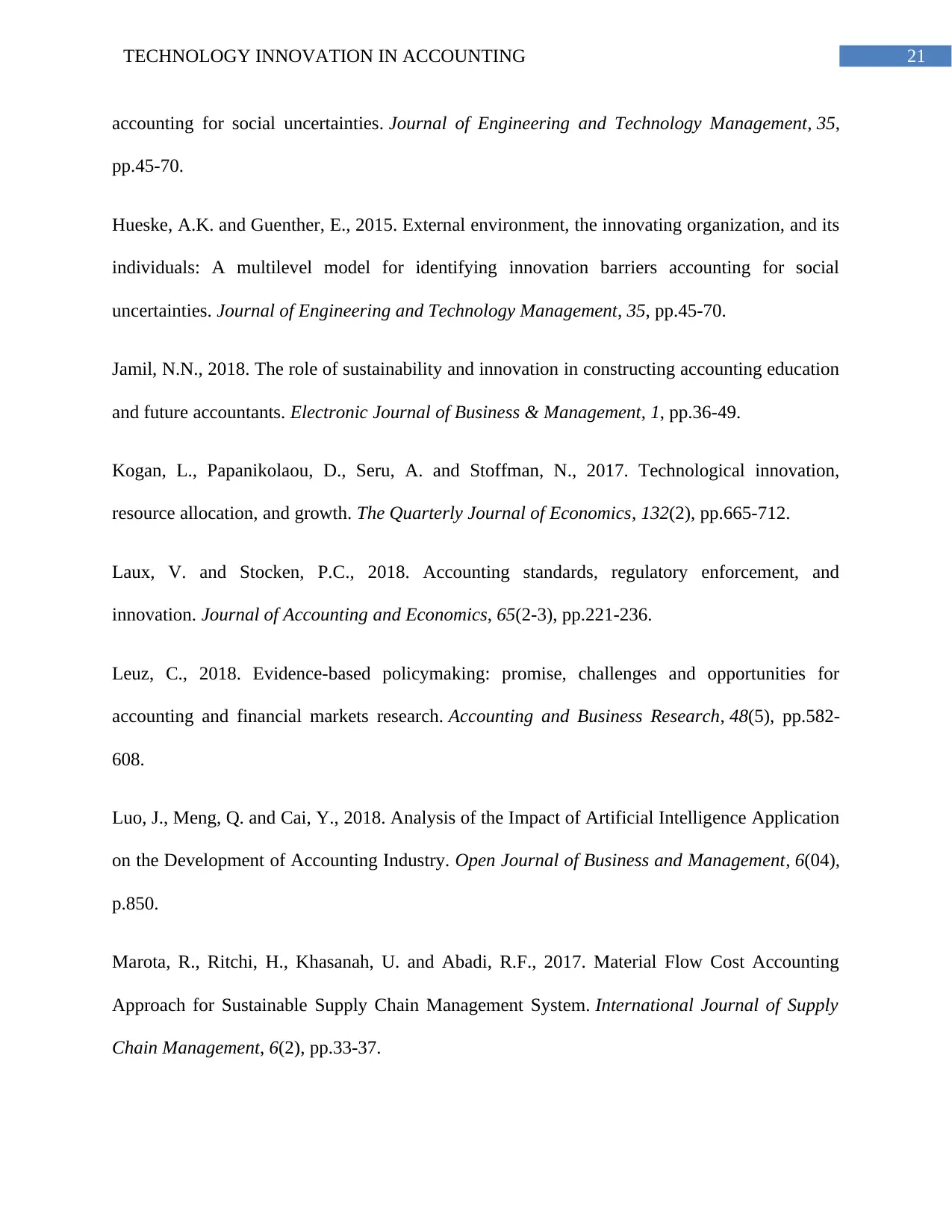
21TECHNOLOGY INNOVATION IN ACCOUNTING
accounting for social uncertainties. Journal of Engineering and Technology Management, 35,
pp.45-70.
Hueske, A.K. and Guenther, E., 2015. External environment, the innovating organization, and its
individuals: A multilevel model for identifying innovation barriers accounting for social
uncertainties. Journal of Engineering and Technology Management, 35, pp.45-70.
Jamil, N.N., 2018. The role of sustainability and innovation in constructing accounting education
and future accountants. Electronic Journal of Business & Management, 1, pp.36-49.
Kogan, L., Papanikolaou, D., Seru, A. and Stoffman, N., 2017. Technological innovation,
resource allocation, and growth. The Quarterly Journal of Economics, 132(2), pp.665-712.
Laux, V. and Stocken, P.C., 2018. Accounting standards, regulatory enforcement, and
innovation. Journal of Accounting and Economics, 65(2-3), pp.221-236.
Leuz, C., 2018. Evidence-based policymaking: promise, challenges and opportunities for
accounting and financial markets research. Accounting and Business Research, 48(5), pp.582-
608.
Luo, J., Meng, Q. and Cai, Y., 2018. Analysis of the Impact of Artificial Intelligence Application
on the Development of Accounting Industry. Open Journal of Business and Management, 6(04),
p.850.
Marota, R., Ritchi, H., Khasanah, U. and Abadi, R.F., 2017. Material Flow Cost Accounting
Approach for Sustainable Supply Chain Management System. International Journal of Supply
Chain Management, 6(2), pp.33-37.
accounting for social uncertainties. Journal of Engineering and Technology Management, 35,
pp.45-70.
Hueske, A.K. and Guenther, E., 2015. External environment, the innovating organization, and its
individuals: A multilevel model for identifying innovation barriers accounting for social
uncertainties. Journal of Engineering and Technology Management, 35, pp.45-70.
Jamil, N.N., 2018. The role of sustainability and innovation in constructing accounting education
and future accountants. Electronic Journal of Business & Management, 1, pp.36-49.
Kogan, L., Papanikolaou, D., Seru, A. and Stoffman, N., 2017. Technological innovation,
resource allocation, and growth. The Quarterly Journal of Economics, 132(2), pp.665-712.
Laux, V. and Stocken, P.C., 2018. Accounting standards, regulatory enforcement, and
innovation. Journal of Accounting and Economics, 65(2-3), pp.221-236.
Leuz, C., 2018. Evidence-based policymaking: promise, challenges and opportunities for
accounting and financial markets research. Accounting and Business Research, 48(5), pp.582-
608.
Luo, J., Meng, Q. and Cai, Y., 2018. Analysis of the Impact of Artificial Intelligence Application
on the Development of Accounting Industry. Open Journal of Business and Management, 6(04),
p.850.
Marota, R., Ritchi, H., Khasanah, U. and Abadi, R.F., 2017. Material Flow Cost Accounting
Approach for Sustainable Supply Chain Management System. International Journal of Supply
Chain Management, 6(2), pp.33-37.
Secure Best Marks with AI Grader
Need help grading? Try our AI Grader for instant feedback on your assignments.
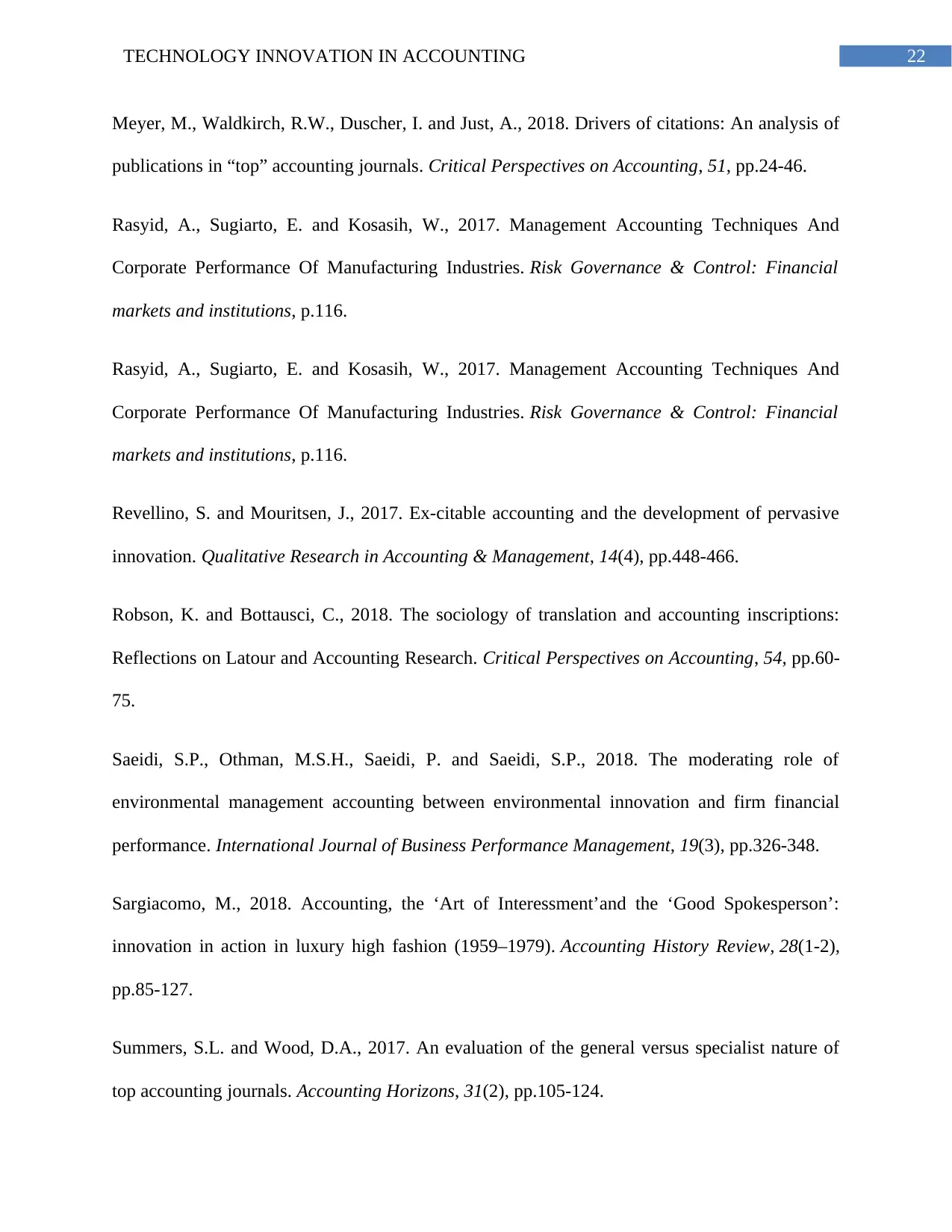
22TECHNOLOGY INNOVATION IN ACCOUNTING
Meyer, M., Waldkirch, R.W., Duscher, I. and Just, A., 2018. Drivers of citations: An analysis of
publications in “top” accounting journals. Critical Perspectives on Accounting, 51, pp.24-46.
Rasyid, A., Sugiarto, E. and Kosasih, W., 2017. Management Accounting Techniques And
Corporate Performance Of Manufacturing Industries. Risk Governance & Control: Financial
markets and institutions, p.116.
Rasyid, A., Sugiarto, E. and Kosasih, W., 2017. Management Accounting Techniques And
Corporate Performance Of Manufacturing Industries. Risk Governance & Control: Financial
markets and institutions, p.116.
Revellino, S. and Mouritsen, J., 2017. Ex-citable accounting and the development of pervasive
innovation. Qualitative Research in Accounting & Management, 14(4), pp.448-466.
Robson, K. and Bottausci, C., 2018. The sociology of translation and accounting inscriptions:
Reflections on Latour and Accounting Research. Critical Perspectives on Accounting, 54, pp.60-
75.
Saeidi, S.P., Othman, M.S.H., Saeidi, P. and Saeidi, S.P., 2018. The moderating role of
environmental management accounting between environmental innovation and firm financial
performance. International Journal of Business Performance Management, 19(3), pp.326-348.
Sargiacomo, M., 2018. Accounting, the ‘Art of Interessment’and the ‘Good Spokesperson’:
innovation in action in luxury high fashion (1959–1979). Accounting History Review, 28(1-2),
pp.85-127.
Summers, S.L. and Wood, D.A., 2017. An evaluation of the general versus specialist nature of
top accounting journals. Accounting Horizons, 31(2), pp.105-124.
Meyer, M., Waldkirch, R.W., Duscher, I. and Just, A., 2018. Drivers of citations: An analysis of
publications in “top” accounting journals. Critical Perspectives on Accounting, 51, pp.24-46.
Rasyid, A., Sugiarto, E. and Kosasih, W., 2017. Management Accounting Techniques And
Corporate Performance Of Manufacturing Industries. Risk Governance & Control: Financial
markets and institutions, p.116.
Rasyid, A., Sugiarto, E. and Kosasih, W., 2017. Management Accounting Techniques And
Corporate Performance Of Manufacturing Industries. Risk Governance & Control: Financial
markets and institutions, p.116.
Revellino, S. and Mouritsen, J., 2017. Ex-citable accounting and the development of pervasive
innovation. Qualitative Research in Accounting & Management, 14(4), pp.448-466.
Robson, K. and Bottausci, C., 2018. The sociology of translation and accounting inscriptions:
Reflections on Latour and Accounting Research. Critical Perspectives on Accounting, 54, pp.60-
75.
Saeidi, S.P., Othman, M.S.H., Saeidi, P. and Saeidi, S.P., 2018. The moderating role of
environmental management accounting between environmental innovation and firm financial
performance. International Journal of Business Performance Management, 19(3), pp.326-348.
Sargiacomo, M., 2018. Accounting, the ‘Art of Interessment’and the ‘Good Spokesperson’:
innovation in action in luxury high fashion (1959–1979). Accounting History Review, 28(1-2),
pp.85-127.
Summers, S.L. and Wood, D.A., 2017. An evaluation of the general versus specialist nature of
top accounting journals. Accounting Horizons, 31(2), pp.105-124.
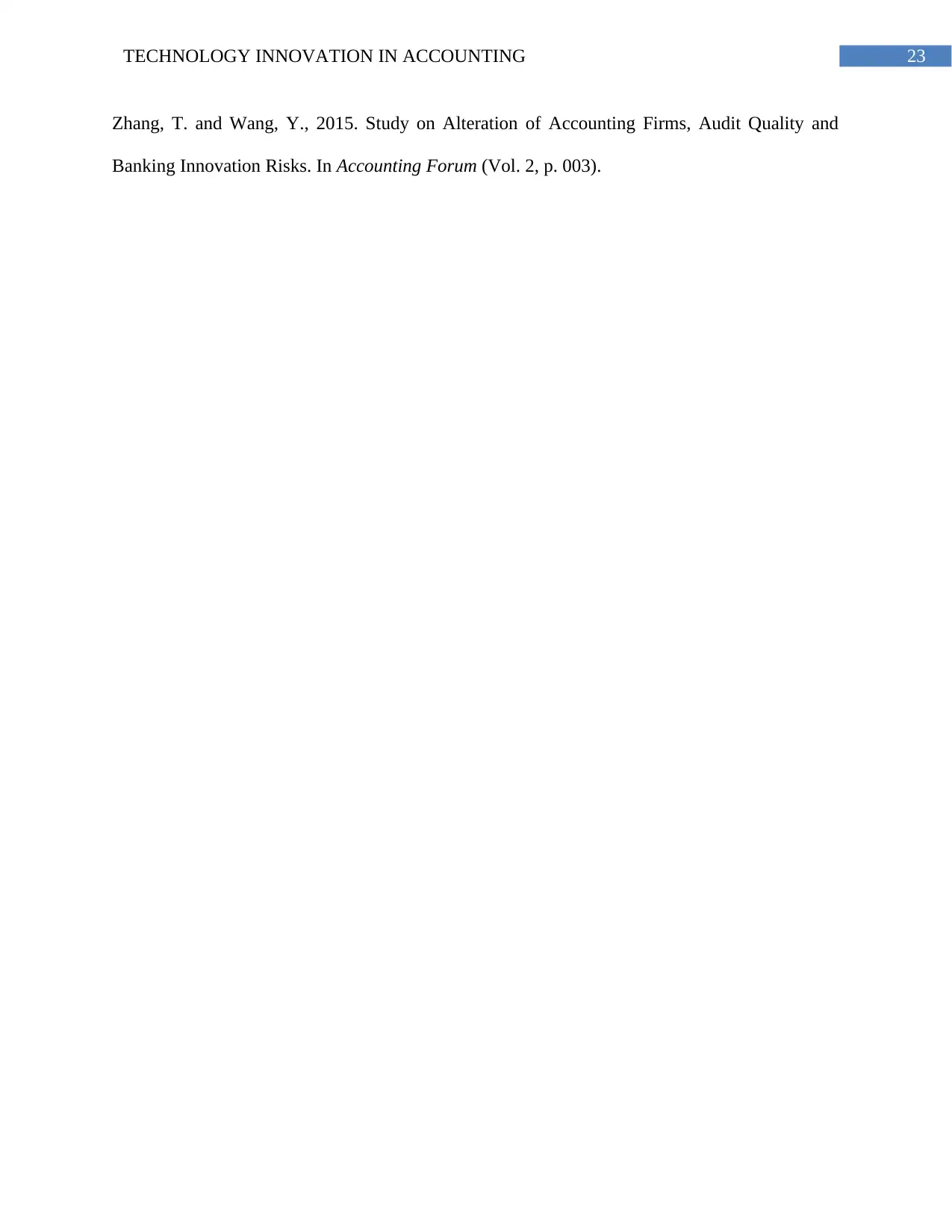
23TECHNOLOGY INNOVATION IN ACCOUNTING
Zhang, T. and Wang, Y., 2015. Study on Alteration of Accounting Firms, Audit Quality and
Banking Innovation Risks. In Accounting Forum (Vol. 2, p. 003).
Zhang, T. and Wang, Y., 2015. Study on Alteration of Accounting Firms, Audit Quality and
Banking Innovation Risks. In Accounting Forum (Vol. 2, p. 003).
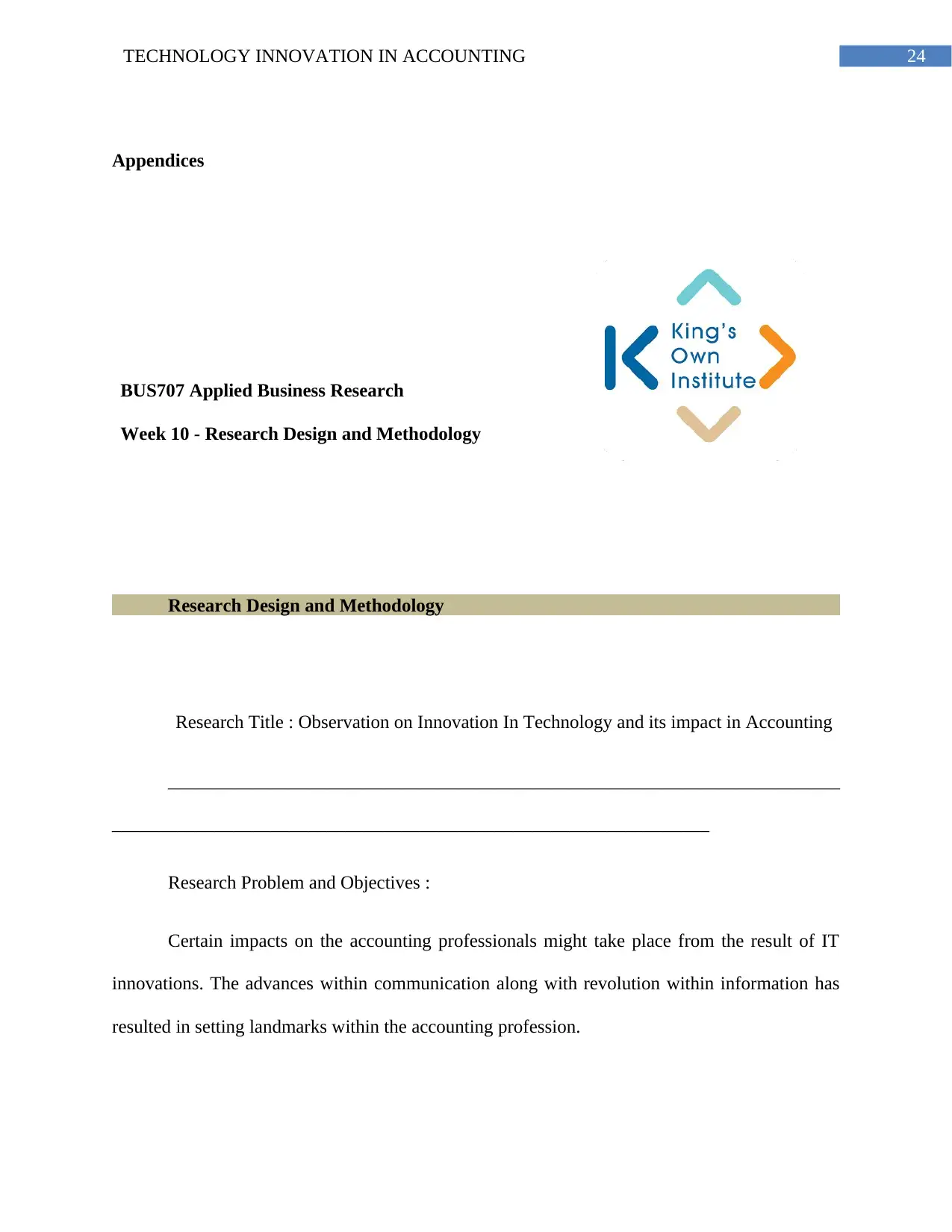
24TECHNOLOGY INNOVATION IN ACCOUNTING
Appendices
BUS707 Applied Business Research
Week 10 - Research Design and Methodology
Research Design and Methodology
Research Title : Observation on Innovation In Technology and its impact in Accounting
________________________________________________________________________
________________________________________________________________
Research Problem and Objectives :
Certain impacts on the accounting professionals might take place from the result of IT
innovations. The advances within communication along with revolution within information has
resulted in setting landmarks within the accounting profession.
Appendices
BUS707 Applied Business Research
Week 10 - Research Design and Methodology
Research Design and Methodology
Research Title : Observation on Innovation In Technology and its impact in Accounting
________________________________________________________________________
________________________________________________________________
Research Problem and Objectives :
Certain impacts on the accounting professionals might take place from the result of IT
innovations. The advances within communication along with revolution within information has
resulted in setting landmarks within the accounting profession.
Paraphrase This Document
Need a fresh take? Get an instant paraphrase of this document with our AI Paraphraser

25TECHNOLOGY INNOVATION IN ACCOUNTING
Considering the aim of this reaserch, the objectives those are to be adressed are
explained under:
To analyse the risk related with implementing innovation within the business practice
To evaluate the uncertainty related with implementing innovation within the business
practice
To deal with the limitations revealed the research to attain best findings from the study
________________________________________________________________________
______________________________________________________________________________
______________________________________________________________________________
______________________________________________________________________________
______________________________________________________________________________
__________________________________________________________________________
Please fill in the table below with the brief information about your research design and
research methodology
Design & Methodology Plan and justification
Research type
(exploratory, descriptive or causal)
the current study will employ exploratory research
design in the recent exploration for the reason that it
leads to better explanation regarding the importance
of accounting technology use in business operations
for attaining better accounting function performance.
Research approach Quantitative research analysis is carried out for the
Considering the aim of this reaserch, the objectives those are to be adressed are
explained under:
To analyse the risk related with implementing innovation within the business practice
To evaluate the uncertainty related with implementing innovation within the business
practice
To deal with the limitations revealed the research to attain best findings from the study
________________________________________________________________________
______________________________________________________________________________
______________________________________________________________________________
______________________________________________________________________________
______________________________________________________________________________
__________________________________________________________________________
Please fill in the table below with the brief information about your research design and
research methodology
Design & Methodology Plan and justification
Research type
(exploratory, descriptive or causal)
the current study will employ exploratory research
design in the recent exploration for the reason that it
leads to better explanation regarding the importance
of accounting technology use in business operations
for attaining better accounting function performance.
Research approach Quantitative research analysis is carried out for the
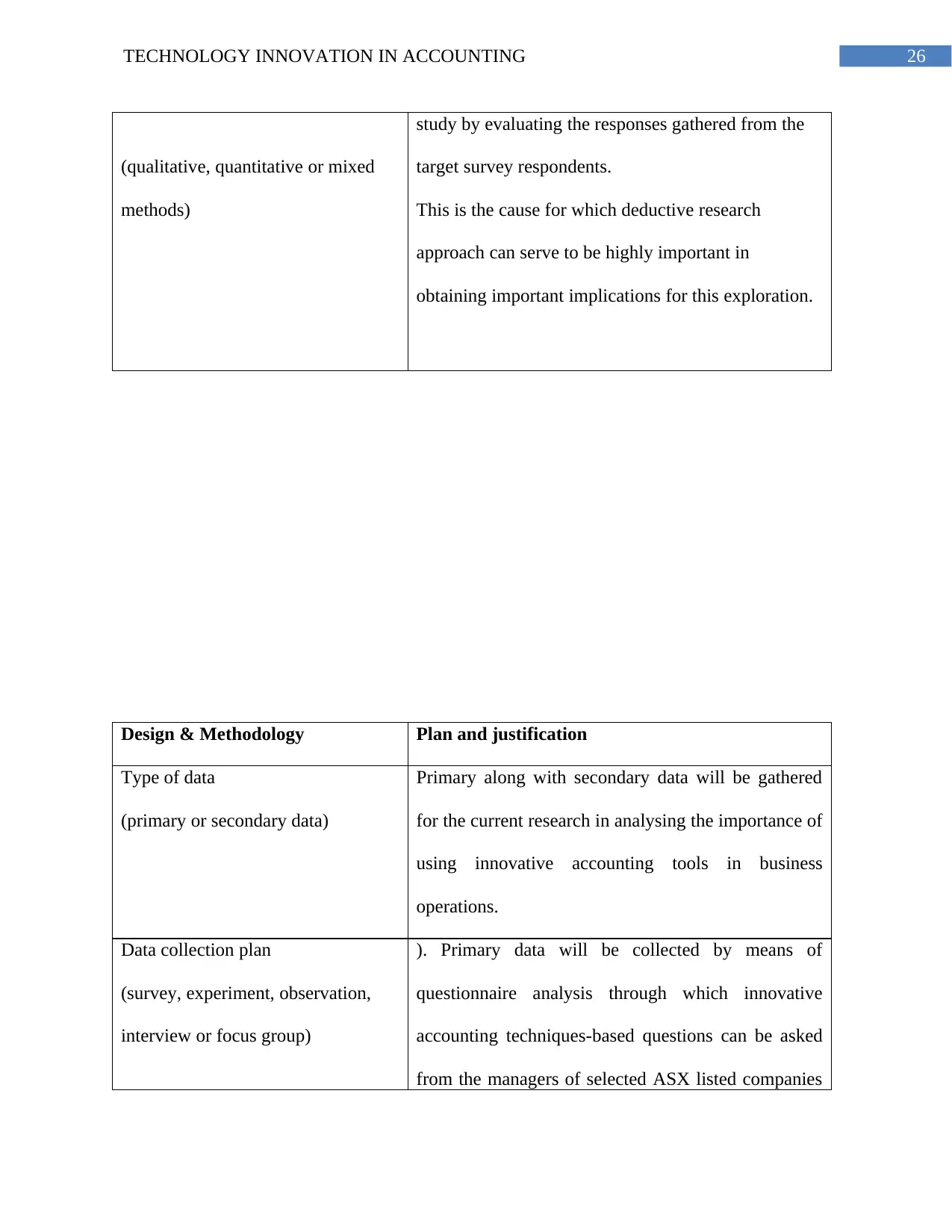
26TECHNOLOGY INNOVATION IN ACCOUNTING
(qualitative, quantitative or mixed
methods)
study by evaluating the responses gathered from the
target survey respondents.
This is the cause for which deductive research
approach can serve to be highly important in
obtaining important implications for this exploration.
Design & Methodology Plan and justification
Type of data
(primary or secondary data)
Primary along with secondary data will be gathered
for the current research in analysing the importance of
using innovative accounting tools in business
operations.
Data collection plan
(survey, experiment, observation,
interview or focus group)
). Primary data will be collected by means of
questionnaire analysis through which innovative
accounting techniques-based questions can be asked
from the managers of selected ASX listed companies
(qualitative, quantitative or mixed
methods)
study by evaluating the responses gathered from the
target survey respondents.
This is the cause for which deductive research
approach can serve to be highly important in
obtaining important implications for this exploration.
Design & Methodology Plan and justification
Type of data
(primary or secondary data)
Primary along with secondary data will be gathered
for the current research in analysing the importance of
using innovative accounting tools in business
operations.
Data collection plan
(survey, experiment, observation,
interview or focus group)
). Primary data will be collected by means of
questionnaire analysis through which innovative
accounting techniques-based questions can be asked
from the managers of selected ASX listed companies
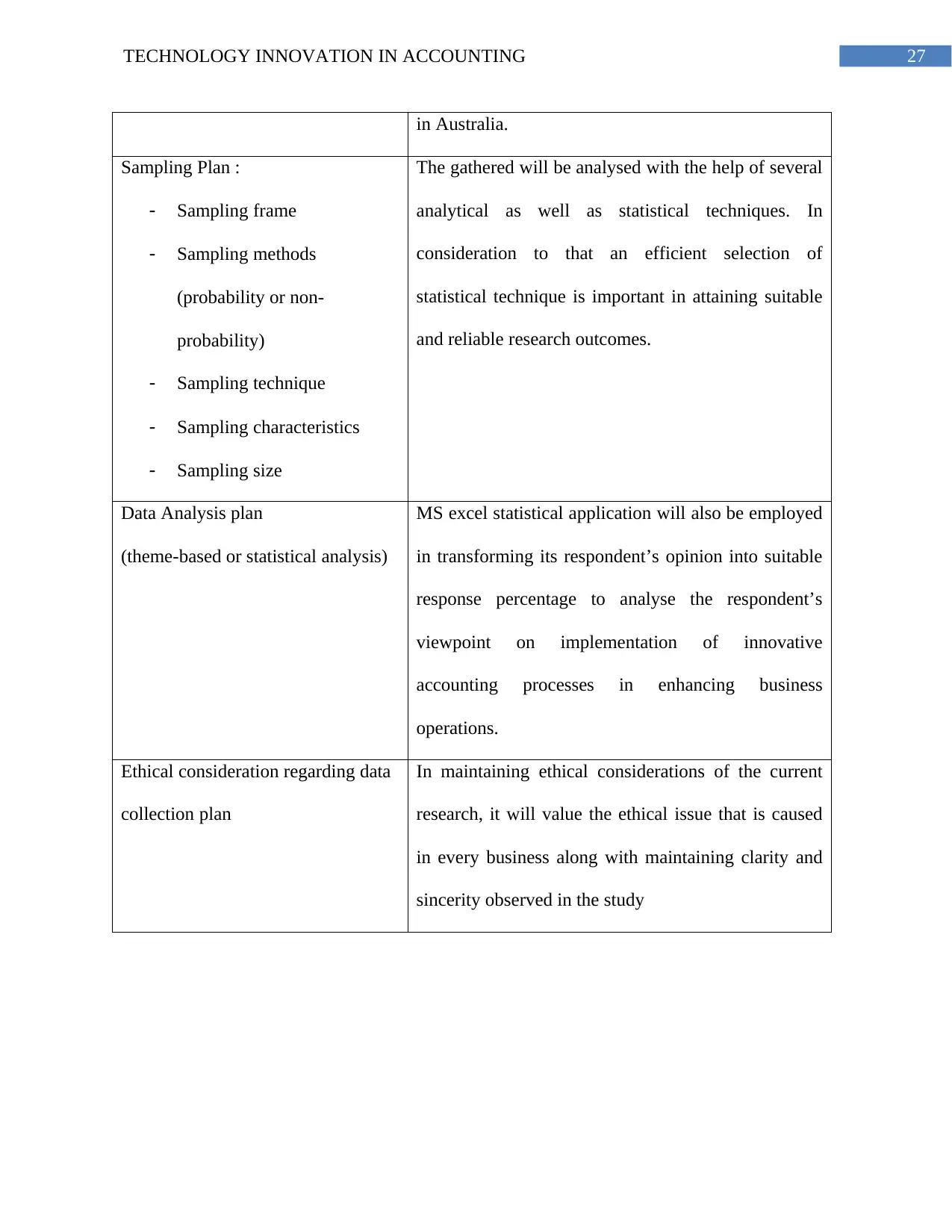
27TECHNOLOGY INNOVATION IN ACCOUNTING
in Australia.
Sampling Plan :
- Sampling frame
- Sampling methods
(probability or non-
probability)
- Sampling technique
- Sampling characteristics
- Sampling size
The gathered will be analysed with the help of several
analytical as well as statistical techniques. In
consideration to that an efficient selection of
statistical technique is important in attaining suitable
and reliable research outcomes.
Data Analysis plan
(theme-based or statistical analysis)
MS excel statistical application will also be employed
in transforming its respondent’s opinion into suitable
response percentage to analyse the respondent’s
viewpoint on implementation of innovative
accounting processes in enhancing business
operations.
Ethical consideration regarding data
collection plan
In maintaining ethical considerations of the current
research, it will value the ethical issue that is caused
in every business along with maintaining clarity and
sincerity observed in the study
in Australia.
Sampling Plan :
- Sampling frame
- Sampling methods
(probability or non-
probability)
- Sampling technique
- Sampling characteristics
- Sampling size
The gathered will be analysed with the help of several
analytical as well as statistical techniques. In
consideration to that an efficient selection of
statistical technique is important in attaining suitable
and reliable research outcomes.
Data Analysis plan
(theme-based or statistical analysis)
MS excel statistical application will also be employed
in transforming its respondent’s opinion into suitable
response percentage to analyse the respondent’s
viewpoint on implementation of innovative
accounting processes in enhancing business
operations.
Ethical consideration regarding data
collection plan
In maintaining ethical considerations of the current
research, it will value the ethical issue that is caused
in every business along with maintaining clarity and
sincerity observed in the study
1 out of 28
Related Documents
Your All-in-One AI-Powered Toolkit for Academic Success.
+13062052269
info@desklib.com
Available 24*7 on WhatsApp / Email
![[object Object]](/_next/static/media/star-bottom.7253800d.svg)
Unlock your academic potential
© 2024 | Zucol Services PVT LTD | All rights reserved.





